Abstract
The article presents a comprehensive study of the energy strategies of both countries, aimed at achieving their goals by 2050. A literature review presents global trends in energy policy, the current situation in Poland and Germany, and the importance of sustainable energy. For Poland and Germany, the current situation, goals, and strategies for 2050 are described, and the results of surveys carried out using a survey questionnaire are presented. A comparative analysis included a comparison of the goals and strategies of both countries and the results of surveys, presented in tabular form. This analysis drew conclusions regarding the differences and similarities in the approach of both countries to energy policy. The “Challenges and Prospects” section identifies potential challenges and presents opportunities and recommendations for the future. In conclusion, the article provides a thorough analysis, based on the methodology of a literature review, survey questionnaire, and tabular analysis, and contains important conclusions and implications for energy policy in Poland and Germany. The article also addresses the limitations of the study that may affect the interpretation of the results.
1. Introduction
Energy policy is a key element for both national security and the country’s long-term economic stability. In the era of global warming and the growing demand for energy, choosing the right energy strategies is becoming not only a technological but also a social and political challenge. The article entitled “Energy Policy until 2050: A comparative analysis between Poland and Germany” aims to thoroughly examine and compare the strategies and energy goals of these two neighboring countries, which, for various reasons, choose different development paths. Poland, with a strong dependence on coal, is betting on a gradual transformation, while Germany is pushing an aggressive decarbonization policy. This analysis is not only an attempt to understand current political decisions, but is also an attempt to answer the question of how these long-term strategies will affect the energy future of Central Europe [1,2,3,4,5].
World energy policy is at a crucial moment of transformation. Striving for sustainability, focusing on renewable energy sources, and the global drive to reduce greenhouse gas emissions shape global strategies and approaches to energy. This lab aims to identify the main trends that will influence global energy policy until 2050.
The decisive trend is the shift from fossil fuels to renewable energy sources. Fast-growing technologies such as solar and wind power are becoming more accessible and competitively priced. At the same time, biomass, geothermal, and hydropower offer sustainable alternatives [6,7,8,9].
The electrification of transport and industrial processes is another key trend. The development of charging infrastructure and progress in battery technology are driving the transition to electric vehicles. At the same time, more and more industry sectors are striving to electrify their processes [10,11,12,13]. The increase in the use of smart grids and energy storage technologies helps to integrate various energy sources. These solutions contribute to the optimization of energy consumption, increasing the efficiency and flexibility of energy systems. At the global, regional, and national levels, policies and regulations play an increasingly important role in shaping the future of energy. Implementing global climate agreements, setting renewable energy targets, and incentivizing energy innovation are key elements of this trend [14,15,16,17].
The implementation of European policy objectives aims to lead the European Union to achieve a low-consumption economy with safer, more competitive, and sustainable energy. The energy goals that should be achieved first are to ensure the security of strategic supplies, the proper functioning of the internal energy market, the reduction of greenhouse gas emissions, and also, and perhaps above all, to confirm one common voice of the EU in the international arena [18,19,20]. The implementation of these goals is intended to contribute to the transformation of Europe into an economy with high energy efficiency and low CO2 emissions [21,22,23]. This will trigger the beginning of a new industrial revolution, accelerating the transition to the stage of economic growth with low CO2 emissions, and in the long term it is expected to result in a significant increase in the production and consumption of locally produced energy with low emissions [24]. Global trends in energy policy until 2050 point to a complex and dynamic landscape where sustainability, innovation, and the global drive to reduce environmental impact are at the forefront. Developing integrated and flexible energy solutions will be key to meeting the growing global energy demand in a responsible and sustainable manner [25,26,27].
2. Literature Review
The main challenges and prospects for the development of the European Union’s climate and energy policy are defined by a detailed set of regulations regarding [28,29,30,31]:
- Strategic challenges related to globalization of energy markets and dependence of EU countries on external markets, technologies for generating energy from available sources in EU countries, defining institutional responsibility in the field of energy security, and counteracting climate change;
- Energy development trends in the global and EU context, including, in particular, the stability of the geopolitical situation, the volume of energy supply and demand in the world and in the EU, innovative technologies for production from renewable energy sources, low-emission coal and gas technologies;
- Guidelines for the implementation of energy policy in the perspective of 2030 and 2050, i.e., integration of the energy market in the EU, increase in energy independence, diversification of energy sources (energy mix), sustainable development, research and development of energy technologies, efficiency of energy use, and the use of new instruments and solutions of the EU’s climate and energy policy.
An important element of the EU’s climate and energy policy and its current greatest challenge is the EU’s solidarity and external policy towards external countries, especially suppliers of energy sources [32]. According to G. Oettinger, EU Commissioner for Energy, “Energy infrastructure is the key to achieving all our goals. It is crucial that we pool resources now and accelerate the implementation of priority EU infrastructure projects” [33]. The priorities of the European Commission include [33,34,35]:
- Energy corridors important for Central and Eastern Europe to be completed by 2050;
- Strengthening connections between national systems (electricity and gas);
- Connection with future wind farms in the North and Baltic Seas;
- Full integration of the currently isolated Baltic countries;
- Strategic infrastructure projects for gas hubs from the Middle East, Azerbaijan, and Turkmenistan (Nabucco and White Stream projects).
Trans-European energy networks must meet the energy challenges arising from Art. 194 of the Treaty of Lisbon, as well as new obligations of the EU, which lists among the strategic goals of energy policy [33,36,37,38]:
- Ensuring the functioning of the internal energy market;
- Ensuring security of energy supplies in the Union;
- Supporting energy efficiency and energy savings;
- Supporting interconnections between energy networks;
- Supporting the development of new and renewable forms of energy.
The implementation of energy policy objectives requires EU Member States, including Poland and Germany, to undertake investment and modernization activities, especially in the field of energy infrastructure. Infrastructure is a critical element of the proper functioning of the entire energy market and has the greatest impact on the efficiency and effectiveness of this market.
2.1. Current Energy Policy in Poland and Germany
Poland has undertaken the task of gradually increasing the share of renewable energy sources in its energy mix. Various support instruments have been introduced, such as the RES auction system, to encourage investment in technologies such as wind, solar, and biomass [39,40,41].
Traditionally, Poland is heavily dependent on coal, especially in the energy sector. The government is working to gradually reduce this dependence and replace coal with other energy sources. The process is complex and requires careful planning to minimize economic and social impacts.
The development of nuclear energy is one of the strategic directions of Poland’s energy policy, aimed at ensuring energy security and diversification of energy sources. There are plans to build nuclear reactors to help replace coal-fired power plants. In Poland, the development of infrastructure for electric vehicles and the desire to increase their market share are noticeable. Various incentives have also been introduced, such as tax reliefs or subsidies for the purchase of electric cars [42,43,44].
Increasing energy efficiency is another important goal. Investments in modern technologies, support for thermal modernization of buildings, and promotion of responsible energy consumption are key elements of this strategy. Poland, as a member of the European Union, must also adapt to common EU goals and regulations regarding climate change, greenhouse gas emissions, and renewable energy sources,
Poland’s energy policy is in a transition phase and is a response to numerous challenges, such as the need to reduce CO2 emissions, increase energy security, and adapt to European standards. This process is complex and requires a balanced approach, taking into account environmental, economic, and social aspects [45,46].
Germany’s current energy policy is one of the most ambitious in the world, especially in terms of promoting sustainable energy and environmental protection.
The Energiewende (Energy Breakthrough) is a key element of German energy policy, which assumes a fundamental transformation of the energy system. The goal is to phase out nuclear and coal energy in favor of renewable energy sources.
After the Fukushima disaster in 2011, Germany decided to gradually withdraw from nuclear energy. The plan assumes the closure of all nuclear power plants in the country by 2022. The German government has decided to phase out coal by 2038. This is a challenge given that coal has traditionally been an important source of energy in Germany. Germany is a leader in the field of renewable energy sources, especially in solar and wind technology. The government offers various forms of support and incentives for RES producers and consumers. Energy efficiency is a key goal of the German energy policy, promoting the increase of energy efficiency of buildings, industrial processes, and transport. Germany is investing in the development of charging infrastructure and technology for electric vehicles, with a plan to significantly increase their market share in the coming years. European integration is a key factor in the European Union, and Germany is involved in shaping and implementing common EU energy and climate goals. The hydrogen strategy is an important element of Germany’s decarbonization drive. Germany plans to become a leader in the production and use of hydrogen in the energy sector. German energy policy is complex and multidimensional, focusing on sustainability, innovation, and integration. It is a response to global challenges related to climate change and sustainable development. Implementation of these ambitious goals requires a complex approach and coordination across multiple government and sectoral levels.
The energy policy of Poland and Germany has several key differences resulting from the historical, geographical, economic, and social differences of both countries. Here are some of the main differences (in Table 1) [47,48,49,50,51].

Table 1.
Analysis of selected aspects of energy policy in Poland and German [52,53,54,55,56,57,58,59,60].
Germany is the world leader in renewable energy sources with ambitious targets, while Poland is developing the RES sector more slowly and with less ambitious targets. Germany has decided to phase out nuclear energy by 2022, while Poland plans to develop this technology as part of its diversification strategy [61,62,63]. Germany plans to phase out coal by 2038, but Poland, being more dependent on coal, faces greater challenges in the process of withdrawing from this dependence on raw materials [64,65]. In the field of electrification of transport, Germany is much more advanced compared to Poland, which is just starting this process. Furthermore, Germany is investing in hydrogen technology as a key element of its decarbonization strategy, while Poland does not have such an advanced plan. Germany focuses on increasing energy efficiency in many sectors, while Poland may have less integrated and ambitious targets in this area [66,67]. Finally, Germany, with its strong economy, has a greater capacity to invest in new technologies, while Poland has to balance the needs of the energy transition with socioeconomic challenges.
While both countries are pursuing a sustainable energy future and share many common goals, the differences in approach, priorities, and process dynamics reflect each country’s unique challenges and circumstances. These differences are crucial for understanding the dynamics and direction of energy policy in Poland and Germany.
Overall, these differences reflect the unique challenges, priorities, and circumstances of the two countries, highlighting the complexity of Europe’s energy transition.
2.2. The Importance of Sustainable Energy
Sustainable energy refers to the generation and use of energy in a way that supports the long-term ability to meet current and future energy needs while minimizing negative environmental and social impacts. Table 2 presents selected key aspects of the importance of sustainable energy.

Table 2.
The importance of sustainable energy [68,69,70,71,72,73,74,75,76].
Sustainable energy supports environmental protection by reducing the emission of harmful gases and pollutants [77,78,79]. Through diversification and efficiency, it ensures greater energy independence, stimulates economic growth through job creation and innovation, and contributes to improving public health by reducing air pollution. It promotes equal access to energy, especially among disadvantaged communities, enables adaptation to future challenges, taking into account climate and natural resources, and is key to achieving the Sustainable Development Goals at the global level [80,81,82].
After all, sustainable energy is not just a matter of technology or economics; it is a complex and multifaceted process that requires the involvement of various sectors of society and governments around the world. This is crucial to building a future that is both green and equitable, and lays the foundation for long-term prosperity and stability.
2.3. Energy Policy in Poland—Goals and Strategies for 2050
Poland’s energy policy for 2050 assumes the achievement of specific goals in the area of energy supply, environment, and energy security. The main strategies focus on achieving a balanced energy mix, reducing greenhouse gas emissions, developing renewable energy sources, promoting nuclear energy, increasing energy efficiency, and ensuring security of energy supplies [83,84,85,86,87]. In 2050, Poland plans to diversify energy sources, minimizing dependence on one fuel, such as coal, in favor of diverse sources, such as natural gas, renewable energy, and nuclear energy. Through this action, the country aims to reduce the negative impact on the environment and increase energy security [88,89,90,91,92,93,94,95,96].
The key objective is to reduce greenhouse gas emissions, mainly related to the generation of energy from fossil fuels. Poland strives to achieve climate neutrality or a significant reduction in emissions to contribute to the fight against climate change, in accordance with international agreements, such as the Paris Agreement [97,98]. The development of renewable energy sources is the key to achieving the goals related to ecology and sustainable development. Energy from renewable sources, such as solar, wind, biomass, and geothermal energy, will constitute a significant share in the supply of electricity in Poland [99,100,101]. The introduction of nuclear energy is also Poland’s strategy for the future. Nuclear power is considered one of the most low-emission energy sources, which will allow Poland to further reduce greenhouse gas emissions [102,103,104,105].
Increasing energy efficiency will be of key importance in achieving the goals of Polish energy policy. By applying more efficient technologies and optimizing energy consumption in various sectors of the economy, Poland intends to reduce the overall energy demand. The last strategy is to guarantee security of energy supply. Poland plans to continue its efforts to increase the country’s energy independence, reduce energy imports, and secure stable supplies. Achieving these goals and strategies will require the commitment of government, industry, investors, and society. The introduction of new technologies, development of energy infrastructure, promotion of innovation, and international cooperation will be crucial for the success of the Polish energy policy for 2050 [106,107,108].
Germany’s energy policy for 2050 focuses on achieving several key goals to ensure a sustainable, ecological, and secure energy supply. The main strategies focus on moving from traditional energy sources to a more diversified energy mix, reducing greenhouse gas emissions, developing renewable energy, promoting energy efficiency, and striving for energy independence [109,110,111,112]. The first key objective is to diversify Germany’s energy sources. This means reducing reliance on one type of fuel, such as coal, and increasing the share of other sources, including renewable energy, natural gas, and nuclear power. Thanks to this, Germany has a chance to ensure the stability of energy supplies and minimize the impact on the environment [90,113,114]. Reducing greenhouse gas emissions is a key element of German energy policy. The country aims to become climate neutral or significantly reduce its emissions to contribute to the global fight against climate change, in line with international agreements such as the Paris Agreement [113,115,116,117].
Increasing the share of renewable energy sources is one of the priorities in the German energy policy for 2050 [118]. Energy from renewable sources, such as solar, wind, biomass, or geothermal energy, plays an increasingly important role in the production of electricity in the country. Promoting energy efficiency is another important strategy. Germany is striving to increase efficiency in various sectors of the economy by using more advanced technologies, optimizing energy consumption and reducing waste [119,120,121,122]. The ultimate goal is to ensure Germany’s energy independence. By developing local energy resources, investing in energy infrastructure, and promoting technology-based solutions, Germany aims to minimize energy imports and ensure stable supplies [123,124,125]. Achieving these goals will require government support, industry and societal commitment, and continued technological innovation. Germany will strive to create international partnerships to jointly pursue the goals of a sustainable and ecological energy policy for the benefit of future generations [126,127,128,129].
Poland’s energy policy for 2050 aims to achieve a balanced energy mix, reduce greenhouse gas emissions, and promote renewable energy and nuclear power. It also focuses on increasing energy efficiency and ensuring energy security. Germany’s energy policy for 2050 focuses on a diversified energy mix, reduced emissions, and the development of renewable energy sources. It also emphasizes energy efficiency and aims for greater energy independence. Both countries recognize the importance of international cooperation and technological innovation in achieving their respective energy goals for a sustainable and ecological future.
3. Materials and Methods
In the study, various research methods were used to present a comprehensive picture of the problem. The authors conducted an in-depth review of both Polish and German and foreign literature to understand the current state of knowledge about energy policies. This article offers an in-depth examination of the energy policies in both countries, targeting the achievement of set objectives by 2050.
In the literature review, there is an illustration of the worldwide tendencies in energy policy, the prevailing conditions in Poland and Germany, and the significance of renewable energy. The current state, objectives, and plans for 2050 in both Poland and Germany are detailed, along with the findings from surveys conducted utilizing a questionnaire.
The side-by-side analysis involves a juxtaposition of the intentions and approaches of both nations, along with survey results displayed in a tabular arrangement. This investigation yielded insights into the disparities and commonalities in how each nation addresses energy policy. The segment titled “Challenges and Prospects” highlights possible obstacles and outlines prospects and suggestions for the years ahead.
The selection of respondents in the professions category was not limited in order to present a diversified picture for the understanding and reception of the energy policy until 2050. Thanks to this, people representing a wide range of sectors can bring a diversified and specialized view of the country’s energy situation in the context of the entire societies of Poland and Germany. Such diversity among respondents promotes an understanding of how energy policy is perceived by different sectors of society and can help in understanding how different professional groups may respond to the policies and challenges related to European Union energy policy. The aim of the survey is to answer the research question:
What is the attitude of the societies of both surveyed countries (Poland and Germany) towards the ongoing energy transformation and are there any differences in the perception of the changes in energy policy?
The survey and the quantitative method were used to answer this question.
As a final point, the article delivers a meticulous examination, employing methods such as review of existing literature, questionnaire surveys, and table-based comparison, and provides significant insights and ramifications for the energy policies of Poland and Germany. It also considers constraints of the study that might influence the understanding of the findings.
4. Results
In order to carry out the study, the random sampling method was used to ensure the representativeness of the selected sample for the target population. Energy policy until 2050 in Poland (from 897 respondents): The target population was Polish citizens over the age of 18, with various demographic and economic backgrounds. Sample size: 897 respondents were selected, which allowed for an adequate level of precision with a margin of error of ±3% and a confidence level of 95%. The sample was differentiated in terms of age, gender, education, and region to reflect the structure of the Polish population.
Energy policy until 2050 in Germany (from 923 respondents): The target population was German citizens over the age of 18 with different demographic and economic backgrounds. Sample size: 923 respondents were selected, which allowed for an adequate level of precision with a margin of error of ±3% and a confidence level of 95%. As in Poland, the sample was differentiated in terms of age, gender, education, and region to reflect the structure of the German population.
The selection of the sample in both countries was carried out in a way that was intended to ensure the representativeness and reliability of the results. The use of consistent sampling methods in both countries allows direct comparison of results and conclusions regarding energy policy up to 2050.
With this approach, the results of the survey can serve as a valuable tool for decision-makers and experts in the energy industry, allowing for understanding and comparison of the opinions and expectations of the public in Poland and Germany in the context of future energy strategies. As part of the analysis of public opinion on various topics, an important element is to understand the demographic profile of respondents. Understanding how different age groups are represented in a study can help in interpreting the results and understanding how different generations view the issues being studied.
In order to illustrate this aspect in detail, Figure 1 is presented below, and shows the age distribution of the surveyed respondents in Poland. This graph comes from our own research and gives a picture of the age structure of the study participants, which may be the key to understanding the differences in responses and attitudes based on age.
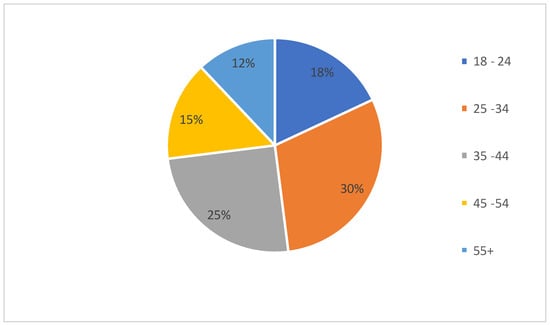
Figure 1.
Age demographics of the surveyed respondents in Poland. Own research.
Here is an interpretation of the results of the survey on the energy policy until 2050 in Poland, in relation to age demographics (age):
- 18–24 years old (18%): This age group, consisting mainly of young adults and students, accounted for 18% of all respondents. This is important because they present new and evolving views on energy, and they can be more open to modern and sustainable energy solutions.
- 25–34 years old (30%): This group, representing younger professional workers, was the largest in the sample, accounting for 30%. Their opinions may reflect a more mature and balanced approach to energy policy, combining both traditional and modern perspectives.
- 35–44 years old (25%): Middle-aged people, who are probably already more stable both professionally and family, accounted for 25%. They may have more conservative views on energy policy or pay more attention to current issues such as cost and availability.
- 45–54 years old (15%): This group, which may already be thinking about future retirement or be at the stage of an average professional career, accounted for 15%. Their opinions may reflect more long-term perspectives and concerns about energy sustainability and stability.
- 55+ (12%): Seniors, who made up 12% of the sample, can bring a unique perspective, based on long-term experience and understanding of historical changes in energy policy. They can also highlight the importance of traditional energy sources and concerns about retirement and sustainability.
The age distribution among the respondents is diverse, which allowed us to capture various perspectives in the study. Younger age groups may lean towards more progressive and sustainable approaches to energy, while older age groups may emphasize stability, tradition, and current challenges. Such differentiation may contribute to a richer and more complex picture of public opinion on energy policy in Poland.
Understanding the professional background of survey respondents can provide valuable clues about their attitudes and opinions. Professions are often associated with specific values, skills, and perspectives, which can influence the way people respond to various questions and issues.
In order to illustrate this dynamic, below is Figure 2, which presents an analysis of the surveyed respondents in terms of their occupation in Poland. These data, derived from our own research, can help the reader understand how different career paths and economic sectors are represented among respondents, and how these differences may affect the overall results of the survey.
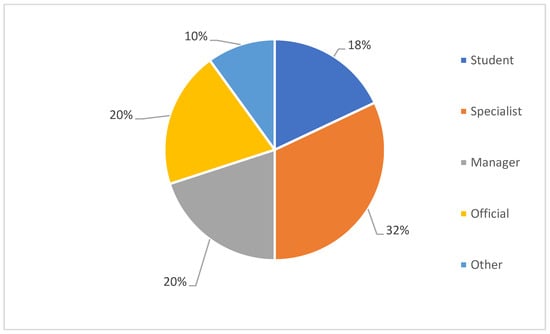
Figure 2.
Analysis of the surveyed respondents in terms of their profession in Poland. Own research.
The analysis of respondents’ occupations in Poland provides valuable insight into the diversity of socioprofessional groups interested in energy policy.
The largest group of respondents are specialists, which may reflect the diversity of this category, covering different fields and skill levels. These can be people working in various sectors of the economy, from IT to healthcare, who have both a direct and indirect impact on the country’s energy policy.
Students are an important group that may be interested in this topic from an educational or research perspective. This is also a group that can play a key role in the future of the energy sector, so understanding their opinions and attitudes is important.
Managers and officials constitute a similar part of the respondents. Managers may represent the business and industry sectors, while officials may represent the public sector. Both of these groups have a direct impact on the direction and implementation of energy policy in the country.
The “Other” group can include a variety of occupations and interests not included in the main categories, from freelancers to retirees.
Overall, this analysis shows that energy policy is a topic that attracts the attention of various professional groups in Poland. This shows the complexity and multidimensionality of the issue and the need to take into account diverse perspectives and interests in the design and implementation of policies in this field.
Education plays a key role in shaping people’s opinions and attitudes on various topics, including issues related to energy policy. The level of education can influence understanding of complex issues, the ability to analyze data, and attitudes towards innovation and sustainable development.
To better understand how education affects respondents’ views on the 2050 energy policy in Poland, see Figure 3 below. This chart provides an analysis of respondents’ education in the survey and comes from our own research. By understanding how different levels of education are represented among respondents, it is possible to better interpret the results and understand how education influences opinions on the future of the energy sector in Poland.

Figure 3.
Education of respondents in Poland in a study on energy policy until 2050. Own research.
The analysis of the education of respondents in Poland in the study on the energy policy until 2050 shows an interesting structure of education of the participants.
The largest group are people with higher education, which may indicate a deep interest in this issue among educated and professionally oriented people. Higher education is often associated with greater environmental awareness and a better understanding of complex energy issues.
People with secondary education also constitute a significant part of the respondents. This group can represent a wide cross-section of society, from technicians and craftsmen to administration and service workers. Their views may reflect a practical approach to energy policy and direct experience with the energy system.
The group with primary education is the least numerous, but its perspective can provide important information about access to information and awareness of energy issues among people with a lower level of education.
The structure of respondents’ education shows that the energy policy until 2050 is a topic that engages people at various levels of education. The higher percentage of people with higher and secondary education may suggest that the discussion on the future of the energy sector is particularly important for those who have education related to technology, science, or management.
Assessing the current situation in the energy sector in Poland is a key element in planning and shaping the future energy policy. Knowing how society assesses the current state of affairs can help decision-makers understand where the current challenges are and what are seen as priority areas for intervention and investment.
Therefore, Figure 4 is presented below, and contains an assessment of the current situation in the energy sector in Poland based on our own research. This analysis can provide important clues about where society sees its greatest successes and challenges, and help in understanding how different groups may differ in their assessments and expectations.
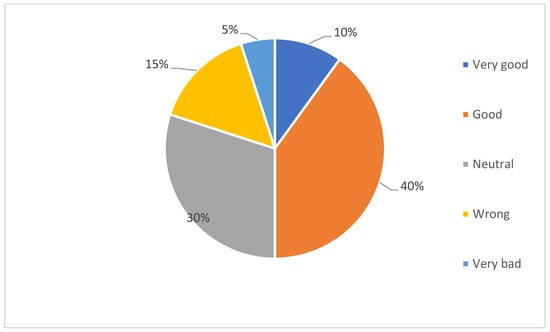
Figure 4.
Evaluation of the current situation in the field of energy in Poland. Own research.
The assessment of the current situation in the energy sector in Poland, based on the collected data, paints a picture full of contradictions and challenges. It is clear that society is divided in its perception of goals and strategies in this area.
A small proportion of respondents are very satisfied with the current situation, which may indicate that the current approach is in line with their values and goals. On the other hand, there is also a significant group that is clearly dissatisfied or even very dissatisfied. This negative reception may indicate a lack of confidence in current strategies, as well as a feeling that these plans are not able to meet the challenges related to the future of the energy sector.
A larger group of respondents who are moderately satisfied may mean that there are some positive aspects of the current situation, but these are offset by other, more problematic issues. A clear proportion of those who answered neutrally may indicate a lack of sufficient knowledge or understanding of energy issues, or may reflect a lack of strong feelings one way or the other. These results suggest that there is much work to be carried out in terms of building public trust and understanding in the field of energy in Poland. The lack of a clear consensus may indicate the need for better communication and public involvement in shaping the future of the energy sector. It may also be necessary to understand what lies behind these different opinions so that strategies can be developed that are more consistent with the values, expectations, and needs of society. The results are an important reminder of the complexity of energy management and planning. Nowadays, it is no longer just about technology and economy, but also about values, trust, and social commitment. Without understanding and responding to these broad and varied expectations, achieving energy goals will be more difficult and potentially less effective. Understanding the biggest energy challenges in Poland is crucial for developing strategies and making decisions that are in line with the realities and priorities of society. Knowing what citizens consider to be the most pressing and relevant issues can lead to more targeted and effective action. In order to present these key challenges, Figure 5 is presented below, and contains an analysis of the survey on the biggest energy challenges in Poland, based on our own research. This chart can provide a deeper understanding of where society sees the greatest needs and challenges, which in turn can help direct resources and attention to those areas that are considered most urgent and critical.
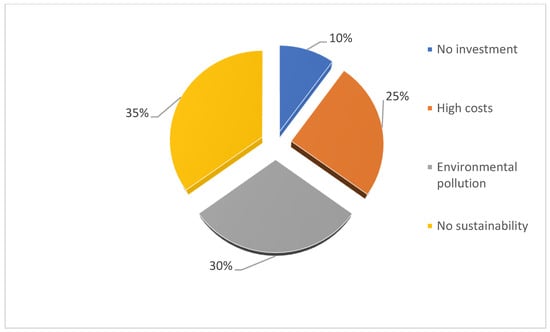
Figure 5.
Analysis of the survey relating to the biggest energy challenges in Poland. Own research.
The analysis of the survey on the biggest energy challenges in Poland paints a picture of a complicated landscape dominated by specific problems and concerns. It seems that the concerns of Poles focus mainly on three areas: high costs, environmental pollution, and lack of sustainable development.
High energy costs are one of the most felt problems for households and businesses. This challenge is directly related to people’s daily lives, affecting their financial capabilities and consumer choices. This indicates the need to look for solutions that can lead to lower energy costs without affecting other key areas such as the environment.
Environmental pollution is another key challenge, reflecting the growing public awareness of the impact of energy on the planet. There seems to be a strong desire to make the energy sector both economically efficient and ecologically responsible. It is a challenge that combines both technology and values, and highlights the need for an integrated approach that balances economic and environmental objectives.
The lack of sustainability, which seems to be a significant percentage of concerns, is probably related to both of the previously mentioned challenges. This may reflect the feeling that the current energy system is inadequately balanced, focusing too much on some goals at the expense of others. This points to the need for a more integrated and holistic approach to energy planning and management that takes into account both short- and long-term goals and challenges.
Slightly less significant, but still important, is the lack of investment, which can be seen as a catalyst or a barrier to other challenges. Without adequate investment, other challenges such as high costs and environmental pollution may be more difficult to overcome.
This analysis indicates that the energy challenges in Poland are complex and multidimensional. There is no one easy solution, and successfully managing these challenges requires an integrated approach that takes into account the economic, environmental, and social aspects of energy. Answering these challenges will likely require both technological innovation and changes in politics and society.
Nowadays, the sources of information people use have a significant impact on their opinions and attitudes. In the context of Polish society, understanding where respondents obtain their information from can provide key clues about what news is most influential and how it can shape public perceptions of various issues.
Therefore, below is Figure 6, which presents the sources of information that respondents in Poland use, according to the results of our research. This analysis can provide valuable insights into which media and platforms are the most influential in Poland and how they can influence public opinion. Interpreting these data can help direct communication and education in the way that will be most effective in achieving intended goals and impacts.
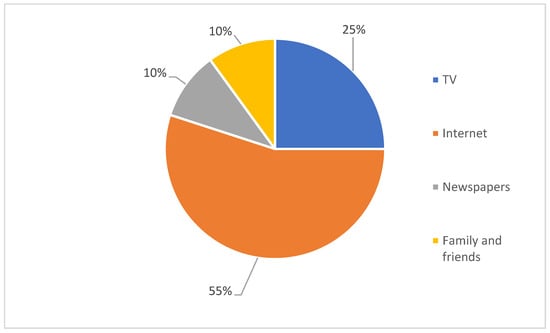
Figure 6.
Sources of information from respondents in Polish. Own research.
The analysis of information sources among respondents in Poland shows that different media play different roles in informing people about energy issues.
The Internet dominates as the main source of information, which reflects the global trend of increasing importance of digital media and access to online information. This may also indicate that younger generations, who are more tech-savvy, may be more involved in these issues.
Television remains an important source of information, although its importance is less than that of the Internet. Nevertheless, for some groups, especially those who are older or less tech-savvy, television can be the main source of information on energy policy.
Newspapers and contacts with family and friends are less significant sources of information. Newspapers may be more popular with older generations, while conversations with family and friends may reflect more informal and personal ways of obtaining information.
The results highlight the importance of a variety of communication channels to reach different social groups. Information and education campaigns should be aware of these differences and use various media to effectively communicate with the public on energy issues. Understanding the energy goals and strategy for 2050 is key to public involvement in these ambitious plans. However, the degree to which people are familiar with these goals can vary, and this difference can influence their opinions and attitudes. Therefore, below is Figure 7, which presents an analysis of the degree of familiarity of the surveyed respondents in Poland with the goals and strategies for 2050, based on our own research. This chart provides important information on how well the public understands and knows these goals, which in turn can affect their ability to support or criticize them. Understanding these dynamics can help guide education and communication in ways that increase awareness and understanding of these important agendas, and, thus, can lead to greater public support and commitment to these goals.
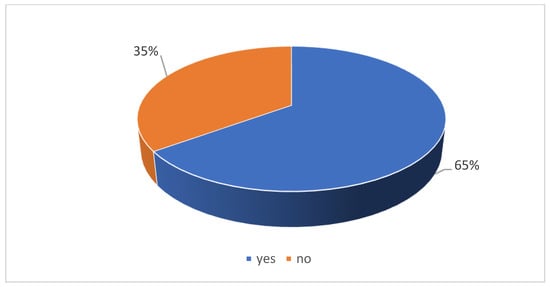
Figure 7.
Analysis of familiarization with the goals and strategies for 2050 by the surveyed respondents in Poland. Own research.
Analysis of the results of the 2050 energy goals and strategies survey in Poland reveals varying levels of awareness among respondents. Most of the respondents expressed that they are familiar with the country’s energy goals and strategies for the future. This may indicate effective communication from the government, organizations, and the media regarding Poland’s long-term vision and energy plans. These people may be more involved in or follow energy news, leading to greater understanding and awareness of these issues. On the other hand, a significant minority of respondents are not familiar with the country’s energy goals and strategies for 2050. This may be due to a lack of interest in the topic, inadequate communication on the part of the relevant actors, or even language barriers and lack of access to information.
They indicate the need for further efforts in the field of education and informing the public about the country’s long-term energy goals and strategies. Follow-up could include clearer and more accessible messages, as well as specific educational campaigns aimed at those who may not yet be familiar with these important issues.
The public’s assessment of goals and strategies in various fields can provide valuable information on how these plans are perceived and how well they align with people’s needs and expectations. The analysis of respondents’ opinions may also indicate potential areas that require additional clarification or modification to be more in line with the interests of society. Therefore, Figure 8 is presented below, which contains an analysis of the assessment of goals and strategies in the opinion of the surveyed respondents from Poland, based on our own research. This graph can provide important insights into where the areas of agreement and disagreement lie between planned goals and public opinion. Understanding these dynamics can help policymakers and planners adjust strategies to better reflect society’s needs, and guide communication and education to explain why certain goals are considered important and how they are to be achieved.
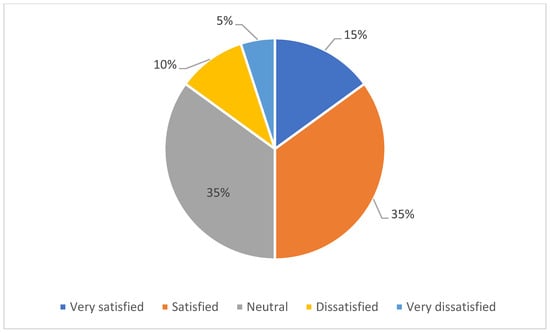
Figure 8.
Analysis of the assessment of goals and strategies in the opinion of respondents from Poland. Own research.
The analysis of the assessment of goals and strategies in the opinion of respondents from Poland shows a complex picture of the social perception of these issues.
The results suggest that the overall tone of the responses is cautious rather than enthusiastic. A small part of society expressed great satisfaction with the current goals and strategies, which may indicate that these goals are in line with their beliefs and expectations, but such opinions are clearly in the minority.
The larger group expressed moderate satisfaction, which may indicate some approval, but also concerns and uncertainty about some aspects of the plans and strategies. It may also suggest that while the direction seems to be right, there are some gaps or areas that require additional attention and improvement.
The most visible, however, is the large percentage of respondents who have a neutral opinion on the assessed goals and strategies. This may indicate a widespread lack of sufficient knowledge or understanding of what the goals and strategies are, or may reflect a feeling that the plans are neither particularly good nor bad. Ultimately, it can also indicate a lack of commitment to these issues, which points to the need for better communication and education.
Severe dissatisfaction, whether moderate or strong, is a clear signal that there is serious concern and opposition to current goals and strategies. This can reflect issues ranging from noncompliance with values and expectations to a lack of confidence in the implementation of plans.
Taken together, these results indicate a complex landscape of opinions about goals and strategies in Poland. There is no clear consensus and different groups have different opinions and reactions. It seems that the key to understanding and responding to these results will be a deeper understanding of what is behind these different opinions. What are the concerns, expectations, and values that shape these responses? Understanding these questions can lead to more effective communication, better public engagement, and more effective delivery of goals and strategies.
Achieving the energy targets for 2050 in Poland will require coordinated action in many different areas. It is important to understand what elements are crucial in the opinion of the public, as these perceptions can influence acceptance and support for different strategies.
In connection with the above, Figure 9 is presented below, and contains an analysis of the key elements that, according to the surveyed respondents, are necessary to achieve the energy goals for 2050 in Poland, based on our own research. This analysis can provide important clues about what society considers to be top priorities and ingredients for success.

Figure 9.
Analysis of the key elements that are needed to achieve the 2050 energy goals in Poland. Own research.
Understanding these perspectives can help shape strategies that are more in line with society’s expectations, as well as direct communication and education to explain why certain elements are crucial and how they will support overall goals. This approach can lead to greater commitment and support in realizing these ambitious plans.
The analysis of the key elements that are needed to achieve Poland’s energy goals for 2050 brings to the fore four main areas of activity. These areas of action are testimony to the complexity of the challenges that Poland must face as it moves to a more sustainable and green energy system.
The first and most important element is investments in renewable energy sources. This points to the need for a significant transformation towards sustainable technologies such as solar, wind, and hydropower. This appears to be a key step towards reducing greenhouse gas emissions and meeting global environmental goals.
Another important element is the improvement of energy efficiency. This means that it is not only about where the energy comes from, but also about how it is used. Improving efficiency can lead to less energy consumption, which in turn can lower costs and reduce environmental impact. International cooperation is also considered a key element of Poland’s energy strategy. The change to a more sustainable energy sector is not a challenge that Poland can face alone. Cooperation with other countries and international organizations can lead to the exchange of knowledge, technology, and funding that are necessary for the successful implementation of sustainable energy solutions. The last, but no less important, element is public education. Without the understanding and support of society, even the best plans and investments can encounter resistance and failure. Educating the public about the importance and benefits of sustainable energy can lead to greater acceptance and commitment to change.
The survey results paint a complex picture of what is needed to achieve Poland’s 2050 energy goals. This is not a task for a single sector or approach, but rather an integrated and sustainable action that combines technology, economics, international cooperation, and public education. Achieving these goals will require careful coordination, innovation, and commitment across multiple levels of society and government, but these results suggest that the way forward is clear and that there is an understanding of the key elements that can lead to success.
Sustainable energy has become one of the key topics of discussion in the global arena, and the opinions and attitudes of society on this subject can significantly influence policy and decisions in this field. In Poland, where the energy sector is undergoing significant changes, understanding how society perceives sustainable energy is particularly important. Below is Figure 10, which presents the opinions and attitudes of the surveyed respondents in Poland on sustainable energy, based on our research. This analysis can provide important insights into what people think about sustainable energy, what attitudes they have towards it, and where there may be areas of support or resistance.
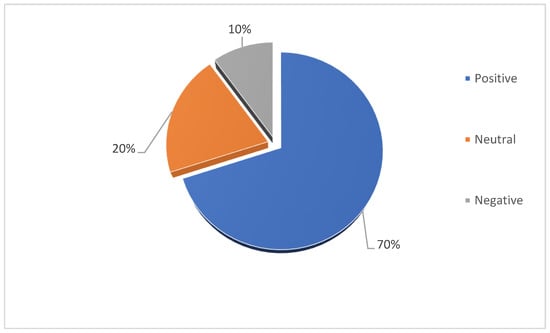
Figure 10.
Opinions and attitudes about sustainable energy in Poland. Own research.
The conclusions of this analysis can help shape policy, communication, and education in a way that takes these opinions and attitudes into account, creating strategies that are more consistent with society’s expectations. It may also indicate where additional educational efforts are needed to increase understanding and acceptance of sustainable energy technologies.
The results of the survey on opinions and attitudes towards sustainable energy in Poland shed light on the current state of public perception of this important issue. It can be seen that sustainable energy is perceived by the majority of Poles in a positive way. This optimistic observation may reflect the growing public awareness of environmental threats and global climate change. It can also signal acceptance and readiness to switch to greener and more sustainable energy sources. However, a significant percentage of neutral answers indicates that many people may not yet be fully convinced of the idea of sustainable energy or do not have a clear opinion on the subject. This may be due to the lack of access to reliable information, unclear communication, or concerns about the potential costs and challenges of implementing such solutions. Finally, a minority of respondents expressed a negative opinion on sustainable energy, which may indicate some barriers or concerns. These may be both economic concerns and lack of confidence in new technologies, or reluctance to change the current energy system.
The extensive conclusions of this survey suggest that there is significant support for the idea of sustainable energy in Poland, but also significant challenges. In order to fully realize the potential of sustainable energy, it may be necessary not only to maintain and develop positive attitudes, but also to focus on education and communication to minimize uncertainty and negative feedback. Achieving this goal may require a complex approach that takes into account both the technical and economic aspects of sustainable energy as well as social psychology and social dynamics. It seems that the key to success will be the ability to build trust and understanding among various segments of society, which may lead to a wider acceptance and effective implementation of sustainable energy solutions in Poland.
Directions of action in the area of sustainable energy are a key challenge for Poland as well as for other countries striving to increase the share of renewable energy sources and minimize the impact on the environment. The choice of these directions must be well thought out, taking into account both the technical possibilities and the expectations of the society. In this context, below, we present Figure 11, which contains an analysis of the directions of action in relation to sustainable energy in Poland, based on our own research. This chart explores what directions are considered most important by respondents and can provide valuable insights into what society considers to be a priority. Understanding these views can help steer activities and investments in a way that is more in line with societal expectations, which can lead to greater support and success in meeting sustainable energy goals. It can also highlight where additional education and communication efforts are needed to ensure that the public is fully aware and engaged in these important lines of action.
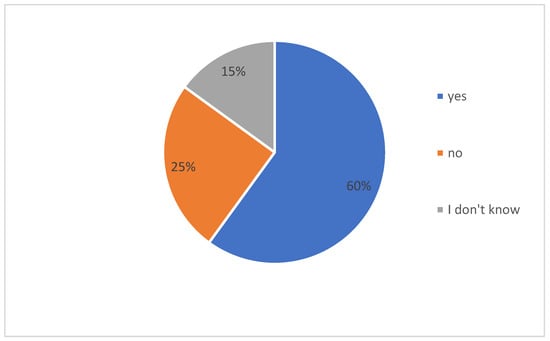
Figure 11.
Analysis of directions of action towards sustainable energy in Poland. Own research.
The results of the survey on the directions of action towards sustainable energy in Poland show a complex picture of society’s attitudes towards this important issue. The survey seems to focus on three main areas: support, opposition, and uncertainty. The majority of respondents expressed support for activities related to sustainable energy in Poland, which suggests that there is general acceptance and understanding of the need to shift towards more sustainable energy sources. This may reflect the growing environmental awareness and understanding of global challenges, such as climate change, which Poland, like other countries, will have to face in the coming decades. However, a significant percentage of respondents expressed opposition to these activities, which may indicate the existence of fears, misunderstandings, or lack of confidence in the proposals and methods of promoting sustainable energy. It may also reflect economic concerns, such as the cost of switching to green energy, or fear of job losses in traditional energy sectors. In addition, the presence of a group of people who answered “I don’t know” suggests that there is some uncertainty and lack of information about what sustainable energy means for Poland and what the consequences of pursuing it may be. This may indicate the need for more education and communication about the benefits and challenges of sustainable energy.
Overall, these results indicate that while there is general support for sustainable energy in Poland, there are also important challenges to consider. Not only must the concerns of those who are opposed be understood and addressed, but efforts must also be made to better inform and involve those who are unsure. Striving for sustainable energy in Poland will probably be a process that requires taking into account a variety of opinions and interests. This includes both promoting understanding and acceptance of sustainable energy goals and working to clarify and overcome fears and uncertainties. A balanced approach that takes these diverse perspectives into account can lead to a more effective and acceptable sustainable energy action plan for Poland.
Analyzing the age structure of the study participants is a key element in understanding and interpreting the results, especially when the study deals with issues that may be perceived differently by different generations. It also gives insight into whether the study represents a broad cross-section of society or focuses on a specific age group. In connection with the above, below, we present Figure 12, which contains an analysis of the age group of participants in a study conducted in Germany, based on our own research. This analysis can provide important information on whether the results of the study can be considered representative of German society as a whole or focused on specific age groups. Introducing this analysis can also help the reader understand how different age groups may differ in their opinions, attitudes, or behaviors on the topic being studied. This can be particularly important if the research is about issues that may have different relevance for different generations, such as technology, climate change, or social policy.
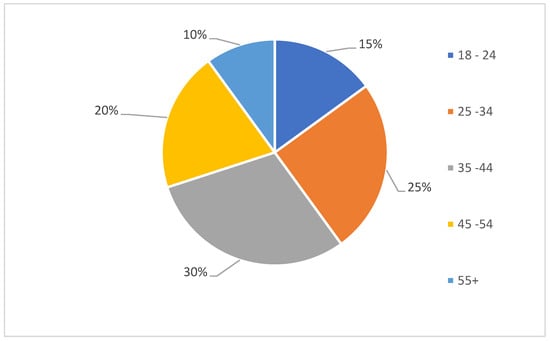
Figure 12.
Analysis of the age group of participants in the study in Germany. Own research.
The results of the survey on energy policy until 2050 in Germany, in which 923 respondents participated, paint an interesting picture of the age diversity of society and its prospects for the future of energy. The presented age data indicate a wide age spectrum of participants, which may suggest that the topic of energy policy is important for different age groups in Germany. Younger generations, aged 18–34, accounted for a total of 40% of the respondents, which may prove their active interest and involvement in issues related to the future of the energy sector. Middle-aged people (aged 35–54) accounted for 50% of the respondents, while people over 55—only 10%.
The age distribution may have different implications for the results of the survey and the direction of energy policy. Younger generations, more familiar with new technologies and perhaps more concerned about climate change, may be more supportive of innovative and sustainable energy solutions. Middle-aged people may focus on current challenges such as energy costs, availability, and reliability, while the older generation may have unique perspectives based on historical experience and long-term observation of changes in the energy sector. The uniformity and diversity of answers between age groups may also indicate a general social consensus on the direction of energy policy or, on the contrary, deep divisions and differences of opinion. The broad representation of different age groups may also indicate the universal importance of energy issues for German society.
Overall, this age diversity may lead to the conclusion that energy policy is a significant issue that affects different segments of society. Therefore, the planning and implementation of energy strategies up to 2050 should take these diverse perspectives into account and strive for a balanced approach that meets the expectations and needs of all age groups. Profession is one of the key factors influencing individuals’ perspectives and opinions. Therefore, understanding how different occupations are represented in the study can provide important insights into the dynamics and results of this study. It can also help the understanding of how different professional sectors influence the perception of the topic under study. Therefore, below, we present Figure 13, which contains an analysis of the respondents of the survey conducted in Germany in terms of their profession, based on our own research. This analysis gives a more complete picture of who took part in the survey and can help in understanding whether the results are representative of the different occupational sectors in German society. Understanding how different occupational groups are represented can also provide insights into how different occupations can influence opinions and attitudes regarding the topic under study. This can be important for interpreting the results and understanding how different sectors of society might respond to policies, technologies, or innovations related to the topic under study.
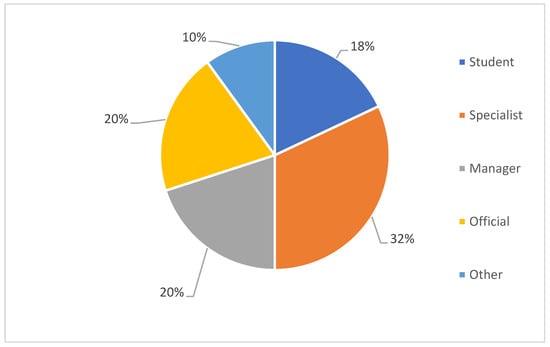
Figure 13.
Analysis of the surveyed respondents in terms of their profession in Germany. Own research.
The results of the survey in the category of occupations present a diverse professional image of respondents in Germany in the context of the energy policy until 2050. Students made up 18% of the sample, which may reflect a younger and perhaps more progressive perspective on the future of the energy sector. Then, the largest group were specialists, whose share was 32%. They represent a wide spectrum of sectors and can bring a diverse and specialized view of the country’s energy situation. Managers and officials, each with a share of 20%, can present a more structured and structured perspective, reflecting their experience in management and administration. Finally, the “Other” category comprises 10% of respondents and is likely to consist of various occupations not included in the main categories, which may indicate an even wider spectrum of opinion. Such professional diversity among respondents is conducive to understanding how energy policy is perceived by different sectors of society and can help in understanding how different professional groups may respond to energy-related policies and challenges in Germany.
Education plays a significant role in shaping people’s opinions and attitudes on various topics, including issues related to energy policy. People with different levels of education may have different views and understandings on issues as complex as long-term energy strategy. That is why we present Figure 14 below, which contains an analysis of the education of respondents in a study conducted in Germany on the energy policy until 2050, based on our own research. This analysis aims to understand how the diversity of education levels among study participants may have influenced the results and interpretations. Understanding these dynamics is crucial as it can help in understanding whether the results are representative of society as a whole or focused on specific educational groups. It can also provide insights into how different levels of education influence opinions and attitudes towards a long-term energy strategy, which is important for designing policies and actions that are in line with the needs and expectations of different sections of society.
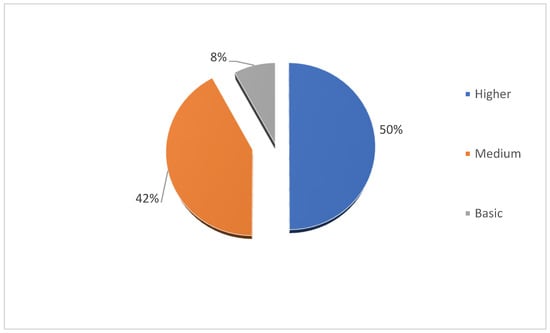
Figure 14.
Education of respondents in Germany in a study on energy policy until 2050. Own research.
The results of the survey regarding the education of participants in Germany in the study on the energy policy until 2050 show a diverse educational picture of society. Only a small part of the respondents, 8%, have primary education. This is a group that may have more practical and direct experience with current energy issues such as cost and availability. Secondary education, represented by 42% of the participants, constitutes a significant part of the sample. These individuals can have a more balanced and comprehensive view of energy policy, combining both practical and theoretical perspectives. The largest group, 50% of respondents, has higher education. This group is likely to bring a more scientific and analytical view of energy issues, with potentially a deeper understanding of the complexities and long-term goals of energy policy. The diversity of backgrounds among survey participants can lead to diverse opinions and perspectives, reflecting different levels of understanding and commitment to energy issues, which may be crucial in shaping future strategies and policies in this field.
Assessment of the current energy situation in Germany is a key element in planning the future of the country’s energy sector. This assessment, which can cover aspects such as energy availability, cost, environmental impact, and energy technologies, can provide important information that is crucial for policymakers, scientists, businesses, and society. Therefore, below, we present Figure 15, which contains an assessment of the current situation in the field of energy in Germany, based on our own research. This chart provides a comprehensive picture of how different aspects of energy are perceived in Germany today. This analysis can help in understanding where Germany stands in relation to its energy goals, what the main challenges and opportunities are, and what the priorities might be in the future. It can also provide valuable insights on how different stakeholder groups perceive the current energy situation in the country, which can be crucial for creating a coherent and effective energy strategy for the future.
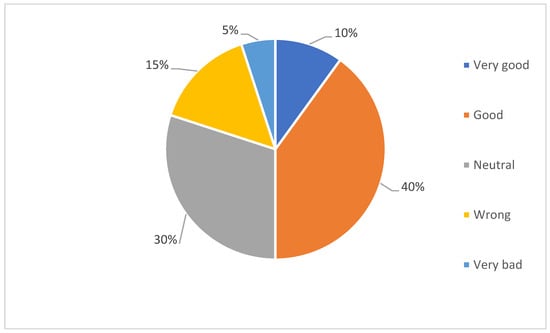
Figure 15.
Evaluation of the current situation in the field of energy in Germany. Own research.
The assessment of the current energy situation in Germany, based on the results of the survey, presents a relatively optimistic picture. Most of the respondents assessed the situation as good or very good, which may indicate general satisfaction with current activities and progress in the field of energy. This positive opinion may reflect effective strategies, investments in sustainable energy, or general acceptance of the direction in which the country’s energy policy is heading. However, there is also a significant group of people who view the situation as neutral. This may indicate some uncertainty or lack of sufficient knowledge about current activities in the energy sector. It may also suggest that for a part of society, energy issues are neither particularly positive nor negative.
On the other hand, a certain percentage of respondents assessed the situation as bad or very bad. This smaller, but worrisome, group may express growing concern or frustration about certain aspects of energy policy, such as cost, pollution, or lack of investment in renewables.
Overall, the picture that emerges is relatively positive, but with clear signs that there are areas of concern and uncertainty that may require further analysis and attention from energy policymakers and practitioners.
Nowadays, as the world moves towards a more sustainable and green energy model, understanding the biggest energy challenges in a given country becomes extremely important. In Germany, a country significantly involved in the energy transition, analyzing these challenges can provide key insights that will help guide future investments, research, and strategies. Below, we present Figure 16, which contains an analysis of the results of the survey on the biggest energy challenges in Germany, based on our own research. This analysis takes into account a variety of aspects and perspectives, such as energy availability and cost, environmental impact, technology and innovation, and social and political factors. The results of this analysis can provide valuable data not only for policymakers, but also for businesses, scientists, and society. This allows the reader to identify key areas for attention, understand differences of opinion between different groups, and plan actions that will contribute to Germany’s energy goals, both nationally and internationally.
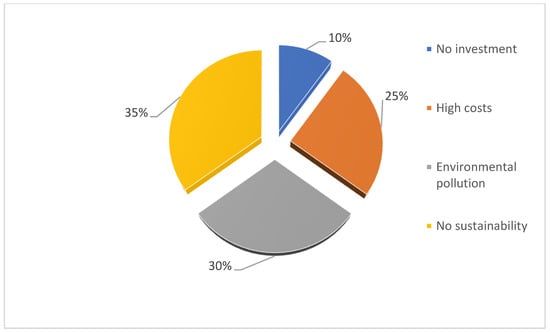
Figure 16.
Analysis of the survey relating to the biggest energy challenges in Germany. Own research.
Most of the respondents’ attention was paid to the lack of sustainable development, which is the most important challenge according to the survey participants. This indicates a growing public awareness of the importance of sustainability and environmental responsibility in the field of energy. It could also suggest that there is some dissatisfaction with the current pace of transition to more sustainable energy sources. Environmental pollution is another key challenge, which may reflect concerns about the impact of energy production on air, water, and soil quality. This challenge is closely related to the concept of sustainable development and shows that ecological issues are an important element of the public debate on energy. High costs are also a significant problem in the opinion of respondents. This challenge may stem from concerns about the availability and affordability of energy for households and businesses, which may affect the quality of life and the competitiveness of the economy.
Lack of investment has received the least attention, although it is also an important aspect that can affect a country’s ability to develop and implement new technologies and shift to more sustainable forms of energy production.
Overall, these results indicate the complexity and multidimensionality of challenges in Polish energy policy. They prove that society is increasingly aware and involved in environmental and economic issues, and understanding these challenges will be crucial for shaping future energy policy and strategy.
Understanding the sources of information that respondents in Germany rely on when forming their views on energy is crucial to understanding the broader context of public opinion and attitudes. These sources may include the media, government reports, research organizations, academic publications, and many other communication channels.
Below is Figure 17, which presents an analysis of the sources of information used by respondents in Germany during research on energy. This analysis, based on its own research, provides valuable insight into which information channels are most influential and credible in German society.
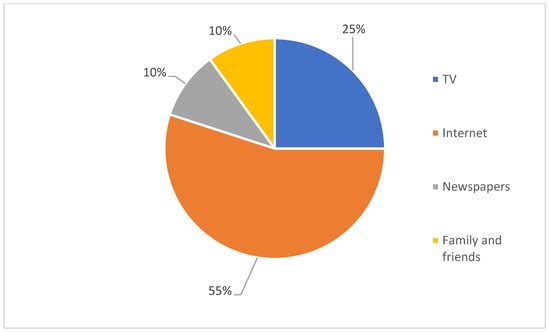
Figure 17.
Sources of information from respondents in Germany. Own research.
These results could have a significant impact on communication and education strategies, both for the government and for companies and nonprofit organizations operating in the field of energy. They can also help the reader understand what the potential barriers and challenges are to communicating key energy issues and how these can be overcome to achieve a broader understanding and acceptance of Germany’s energy goals and strategies.
The results of the survey on sources of information on energy policy in Poland paint an interesting picture of how people learn about energy issues. It is clear that the Internet dominates as the main source of information, which may reflect the increasing role of digital media and social platforms in shaping public opinion. Television ranks second, indicating that traditional media continue to play an important role in informing the public about energy issues. This may also indicate that older generations, who may be less active online, still rely on television as their main source of information. Newspapers and friends or family are less popular sources of information, but they cannot be ignored. They can play a key role in certain communities or among certain demographics.
Overall, these results highlight the importance of a variety of communication channels in achieving broad understanding and commitment to energy policy. They can also have implications for the planning of information and education campaigns, allowing messages to be targeted at different sections of society in the most effective way.
In the field of energy, achieving a sustainable and efficient energy model requires not only technology and investment, but also understanding and commitment from society. In Germany, where the 2050 plans are an important element of the country’s energy strategy, understanding how familiar the public is with these goals and strategies can have a significant impact on their successful implementation.
Below, we present Figure 18, which contains an analysis of the level of familiarity of respondents in Germany with the goals and strategies for 2050 in the field of energy, based on our own research. This analysis can provide valuable insights into how society perceives and understands these goals, as well as potential barriers to communication and education on the topic. These results can serve as a tool for policymakers, businesses, and community organizations to better tailor their messages and actions to increase awareness and understanding of these key issues. This can increase public involvement and support the achievement of Germany’s 2050 energy targets, both nationally and locally.

Figure 18.
Analysis of familiarization with the goals and strategies for 2050 by the surveyed respondents in Germany. Own research.
The results of the survey on respondents’ familiarity with the 2050 energy goals and strategies in Poland show some awareness among the public. Most respondents say they are familiar with the country’s energy goals, which may indicate effective communication from government and stakeholder organizations. However, a significant part of society is not aware of these goals, which indicates the existence of an information gap.
This gap may mean that messages about energy goals are not reaching all segments of society or are presented in a way that is not accessible to them. Unawareness of these goals among a significant part of society may be a challenge to achieve broader support and commitment to the energy goals for 2050.
These results can therefore provide important feedback to policymakers and communicators, suggesting that there is a need for increased education and communication efforts in this area to ensure full understanding and support for the direction the country’s energy policy is heading.
The analysis of energy goals and strategies is not complete without understanding how they are perceived and evaluated by society. In Germany, where the 2050 strategies aim to transform the energy sector, public opinion can play a key role in shaping and implementing these plans.
Figure 19 below presents an analysis of the assessment of goals and strategies in the opinion of respondents from Germany, based on our own research. This analysis can provide important information on how different aspects of the strategy are perceived by the public, as well as potential areas that may require additional clarification or communication.
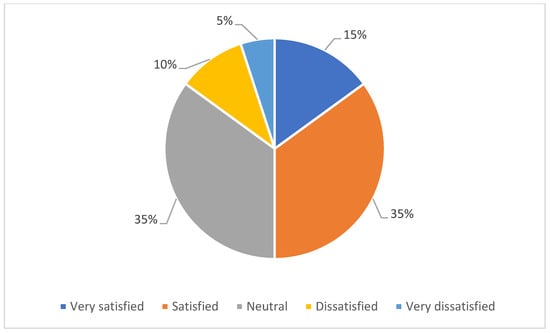
Figure 19.
Analysis of the assessment of goals and strategies in the opinion of respondents from Germany. Own research.
Conducting such an analysis can help policymakers and stakeholders understand where there may be differences between government goals and society’s expectations and values. It can also provide guidance on how to increase acceptance and support for these goals by adapting communication, consultation, and education. Finally, these results can also help identify areas where goals and strategies can be more aligned with the values and interests of society, which can contribute to their more effective implementation.
The results of the survey regarding the assessment of energy goals and strategies for 2050 in Poland present mixed feelings among respondents. There is general satisfaction with the current plans, as can be seen from the fact that a significant proportion of respondents expressed themselves positively. However, an equally large percentage of people do not have a firm opinion on this subject, which may indicate uncertainty or lack of sufficient knowledge about these plans.
The small, but worrying, percentage of dissatisfied and very dissatisfied points to some disagreements and fears that may exist among some social groups. These may be people who are concerned about the impact of these plans on their professional or personal lives, or those who feel that these plans lack ambition or scope. Such diverse opinions suggest that shaping and communicating 2050 energy goals and strategies may require a balanced approach that takes into account both the aspirations and concerns of different segments of society. This also highlights the need for further education and dialogue about these plans to ensure a more consistent and comprehensive understanding and support. Achieving the ambitious energy targets for 2050 in Germany requires a comprehensive approach and understanding of the key elements that are necessary to achieve them. Choosing the right strategies, technologies, and measures can make or break these efforts, so it is important to understand what factors are most important to the public.
Below is Figure 20, which provides an analysis of the key elements that respondents say are needed to meet Germany’s 2050 energy targets, based on our own research. These results can provide important clues as to which areas and measures can be prioritized in the planning and implementation of energy strategies. Are investments in renewable energy sources considered the most important, or does society pay attention to education, international cooperation, or other aspects? Understanding these priorities can help the reader identify the most effective paths to achieve your goals, as well as build stronger public support for these efforts.
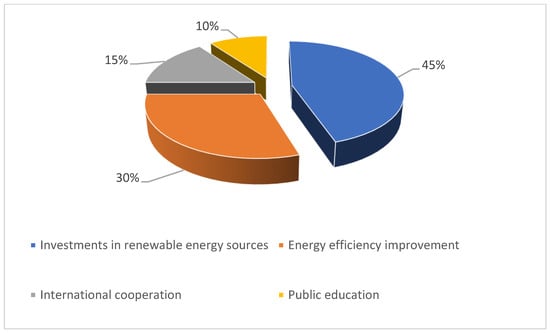
Figure 20.
Analysis of the key elements that are needed to achieve the 2050 energy goals in Germany. Own research.
These results can serve as an important tool for governments, businesses, scientists, and civil society organizations in Germany, providing them with valuable support in the decision-making process and the implementation of plans related to the country’s energy transition.
The results of the survey in relation to the key elements that are needed to achieve the energy goals by 2050 show society’s priorities in this area. The greatest emphasis is placed on investments in renewable energy sources. This demonstrates the growing awareness of society about the importance of sustainable energy and the need to reduce dependence on fossil fuels.
Improving energy efficiency is also important to respondents, suggesting that understanding the need for more efficient use of energy, both at the industrial and domestic levels, is becoming more widespread. International cooperation and public education were less emphasized by the respondents, but they are still important elements. Public education, although considered less crucial, is still important, especially in the context of raising awareness and engaging the public in energy issues.
Overall, these results indicate that society recognizes the need to shift to more sustainable and efficient forms of energy. However, differences in perceptions of key elements may also suggest that there is still a long way to go in terms of education and communication about how these goals can be achieved and what this means for the average citizen. Understanding public opinion and attitudes towards sustainable energy is crucial in the context of the transition to greener and more efficient energy systems. Social attitudes can influence the acceptance and adoption of new technologies, support for government policies, and energy-related behavior in everyday life.
Below, we present Figure 21, which shows the results of our own research on opinions and attitudes towards sustainable energy in Germany. This graph provides valuable insights into how German society perceives various aspects of sustainable energy, including its benefits, challenges, and how these attitudes can influence decision-making processes at various levels.
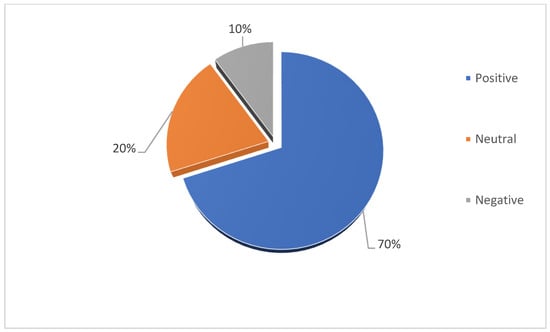
Figure 21.
Opinions and attitudes about sustainable energy in Germany. Own research.
The clear predominance of positive opinions proves the growing interest and acceptance of the concept of sustainable energy. This may be due to the growing public awareness of climate change and the need to protect the environment.
The existence of a significant percentage of neutral opinions suggests that there is also room for education and awareness about sustainable energy. This can apply to both the benefits and potential challenges of this form of energy. A small number of negative opinions may indicate concerns and misconceptions about sustainable energy. This may require further research to understand why some people are averse to the idea. Are these fears related to costs, availability, or maybe a lack of confidence in new technologies?
The overall picture of the opinion suggests that there is great potential for the development and implementation of sustainable energy solutions. Government, businesses, and organizations can use this feedback to develop strategies that will promote and develop sustainable energy. The application for the importance of neutral and negative feedback highlights the need for further education and open communication. Explaining the benefits, dispelling myths and fears, and presenting real data and facts can help build even wider public support.
A positive view of sustainable energy can lead to greater social pressure on companies and governments to integrate these practices into their operations. This may influence policy, regulation, and corporate initiatives in the future. As one of the leading countries in the field of sustainable energy, Germany is taking various measures to accelerate the energy transformation. The development of technology, investments in renewable energy sources, and the promotion of energy efficiency are just some of the directions that may be crucial to achieving the goals related to sustainable energy.
Figure 22 below presents the results of our own research on the analysis of directions of action in Germany in the field of sustainable energy. This graph illustrates what actions are considered most important and how they are rated by different groups of respondents. This analysis can provide key insights for governments, businesses, and other stakeholders who want to understand what strategies and actions are most appropriate to achieve energy goals. It can also help identify areas that need more focus or extra support. Therefore, Figure 22 is an important tool for those who want to make informed decisions on Germany’s future energy policy, understand priorities and challenges, and shape actions that will truly impact the country’s sustainable energy future.
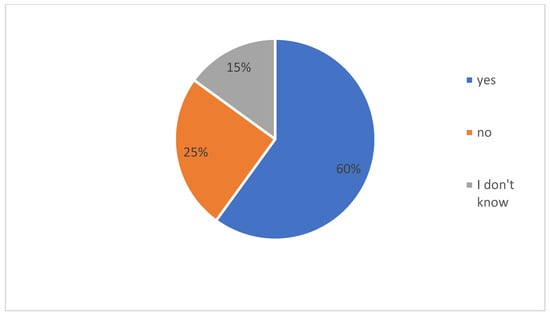
Figure 22.
Analysis of directions of action towards sustainable energy in Germany. Own research.
The results of the national direction survey show a mixed picture of public opinion on the subject. The majority of respondents agree with the current direction of the country’s activities, which may indicate general support for the current policy or strategy of the government in key areas such as economy, social, or external policy. However, a significant proportion of respondents expressed disapproval of the current direction, which may indicate the presence of some dissatisfaction or controversy among the public. These may be people who feel that their needs and values are not properly represented in current government activities. Moreover, the group of respondents who answered “I don’t know” cannot be ignored. This category may indicate a lack of sufficient awareness, understanding, or certainty about the direction in which the country is headed. It may also reflect a lack of involvement in current political and social events.
Overall, these results reveal a complex picture of public opinion that reflects the diversity of views and expectations among the public. They indicate the need to take into account different perspectives and to engage more in dialogue with various interest groups in order to build a broader understanding and consensus around key national issues.
5. Discussion
We present, below, an interpretation and comparison of the results of the surveys on the energy policy until 2050 in Poland and Germany. For Poland, there are more young respondents aged 18–24 (18% compared to 15% in Germany) and aged 25–34 (30% compared to 25% in Germany). For Germany, there are more middle-aged people, 35–44 (30% compared to 25% in Poland). For both countries, there is a similar percentage of people aged 55+ (12% in Poland and 10% in Germany). Poland has more professionals (35% vs. 32% in Germany) but fewer students (20% vs. 18% in Germany). The percentage of managers and clerks and other occupations is the same in both countries.
For Germany, there are more people with secondary education (42% compared to 40% in Poland) but fewer people with primary education (8% compared to 10% in Poland). Tertiary education is at a similar level in both countries (50%). There is a much better perception of the current situation in Germany, with 50% rating it as good or very good, compared to 25% in Poland. In Poland, more respondents rated the situation as bad or very bad (35% compared to 20% in Germany).
Both countries report environmental pollution and lack of sustainability as major challenges, but they are also more concerned about high costs in Poland (30% vs. 25% in Germany). Germans are less worried about the lack of investment (10% compared to 15% in Poland). The Internet is the main source of information in both countries, but more so in Germany (55% compared to 50% in Poland). Television is slightly more popular in Poland (30% compared to 25% in Germany). In Germany, a higher percentage of respondents are familiar with the objectives (65% compared to 55% in Poland). Germans are more satisfied with the goals and strategies (50% satisfied or very satisfied compared to 25% in Poland).
Both countries prioritize investments in renewable energy sources and improving energy efficiency, but in Germany there is a greater emphasis on investing in renewable sources (45% compared to 40% in Poland). Positive opinions are more common in Germany (70% compared to 60% in Poland). In Germany, more people believe that the country’s course of action is right (60% compared to 40% in Poland).
There is greater uncertainty about the direction of the country’s actions in Poland, with 20% of respondents answering “I don’t know”, compared to 15% in Germany. Germany shows a higher level of satisfaction with the current energy situation and strategy, as well as a higher commitment to renewable energy sources. Poland shows more concern about costs and lack of investment, with lower levels of satisfaction and familiarity with the goals.
Education and occupation are relatively similar in both countries, but the age distribution shows that there are more younger respondents in Poland. These differences may result in different priorities and opinions in the two countries, highlighting the importance of understanding the social and economic context in the design and implementation of energy policy.
The geopolitical situation and external EU policy, including the implementation of strategic infrastructure projects, will have a fundamental impact on the energy market and possible ways of solving many energy and climate challenges that have a direct impact on the functioning of basic areas of life [130,131,132]. The EU’s policy of increasing the share of renewable energy and nuclear energy in the energy mix of member states is intended to influence both the dependence on imported fossil fuels and the ongoing climate change [133]. While this solution seems good in its intention, there are problems with its implementation.
The goals of the EU’s energy policy and strategic economic goals cannot be achieved without a fundamental change in the methods of developing European infrastructure [134]. Existing legal regulations regarding the preparation and implementation of infrastructure investments do not provide support and even hinder the investment process. Barriers and difficulties occurring during infrastructure investments concern legal, administrative, and social aspects. There is an urgent need to develop and adopt radical legal solutions to facilitate the expansion and modernization of energy infrastructure [135]. Experts forecast that the lack of appropriate legal regulations enabling the development of infrastructure may in the future result in the inability to cover the demand for energy utilities, paralysis of the functioning and development of the economy, trade, and transport, and, thus, stagnation of the economy and employment. The weakness of the current method of meeting energy demand is manifested by many elements of risk: physical, economic, social, and environmental. Moreover, the emergence of instability should be expected, resulting from the continuation of existing trends and political solutions, inadequate to the dynamically changing internal conditions and in the EU environment. The divergence of interests results from a whole range of conditions, from economic to social to historical. Additionally, due to the enormous amount of bureaucracy, decision making and the legislative process in the EU are very slow and create new challenges and problems.
6. Conclusions
Poland has a higher number of young respondents, which indicates a greater involvement of young people in energy issues. Germany has more middle-aged respondents, which may indicate differences in generational interests in these countries. Poland has a higher percentage of specialists participating in the survey, which may indicate a greater interest in energy policy in this group. Differences in occupations indicate different occupational groups that are more involved in energy issues in both countries.
Germany has a higher percentage of people with secondary education, and Poland has more people with primary education. This may indicate differences in access to education or differences in the educational structure. A marked difference in the perception of the current energy situation between countries may indicate differences in communication between governments or real energy challenges.
Concern about high costs in Poland may indicate a higher sensitivity to the price of energy. Germany seems to focus more on environmental pollution and sustainable development. Differences in the main sources of information can affect the way these societies perceive and interpret energy policy. The higher percentage of familiar respondents in Germany may indicate more effective government communication. A clearly higher level of satisfaction in Germany may indicate greater public confidence in government policy. Differences in investment priorities may reflect differences in energy strategy and environmental awareness. Greater support in Germany may indicate a more sustainable energy culture. Differences in perceived national direction may reflect differences in satisfaction with current energy policy and trust in government. Greater uncertainty in Poland may also indicate the need for better communication and education in the field of energy.
The limitations of the study were the number of respondents and their statistical significance for the image of entire societies. Therefore, it is important to extend research to a larger number of people from given societies. Public statistical institutions have natural opportunities for this type of research. Additionally, an important element of future research should be experts and political groups, which often decide on the direction of energy strategy against the will of the majority of society. Therefore, such complementary research in the future will be necessary in order to effectively forecast the energy policies of individual countries or associations of nations, such as the European Union. However, due to the strategic nature of the issue for the entire EU economy, the issue of common energy policy is often discussed, quickly becoming one of the most important EU priorities, which is a positive sign and may give hope for an improvement in the situation in the future. International politics and the threat resulting from Russia’s aggressive actions may be a particular driving force for changes leading to a uniform and coherent EU energy policy. The most important priorities in the 2050 perspective specified in EU documents are ensuring external supplies, where international policy and infrastructure projects play a fundamental role, while intensifying the use of internal EU resources, improving energy efficiency, creating conditions for competition on the internal energy market, and counteracting carbon dioxide emissions.
Author Contributions
Conceptualization, H.W., I.M., D.M., A.S., M.S. (Mariusz Sikora), A.W.-C., M.S. (Małgorzata Smolarek), A.K. and M.C.; methodology, H.W., I.M., A.S. and A.K.; formal analysis, H.W., I.M., D.M., A.S., M.S. (Mariusz Sikora), A.W.-C., M.S. (Małgorzata Smolarek), A.K. and M.C.; resources, H.W., D.M., A.W.-C., M.S. (Mariusz Sikora), A.K. and M.C.; data curation, H.W., I.M., D.M., A.S., M.S. (Mariusz Sikora), A.W.-C., M.S. (Małgorzata Smolarek), A.K. and M.C.; writing—original draft preparation, H.W., I.M., D.M., A.S., M.S. (Mariusz Sikora), A.W.-C., M.S. (Małgorzata Smolarek), A.K. and M.C.; writing—review and editing, H.W., I.M., D.M., A.S., M.S. (Mariusz Sikora), A.W.-C., M.S. (Małgorzata Smolarek), A.K. and M.C.; visualization, H.W., I.M., D.M., A.S., M.S. (Mariusz Sikora), A.W.-C., M.S. (Małgorzata Smolarek), A.K. and M.C.; supervision, H.W. and I.M.; project administration, H.W., I.M., D.M., A.S., M.S. (Mariusz Sikora), A.W.-C., M.S. (Małgorzata Smolarek), A.K. and M.C.; funding acquisition, H.W., I.M., D.M., A.S., M.S. (Mariusz Sikora), A.W.-C., M.S. (Małgorzata Smolarek), A.K. and M.C. All authors have read and agreed to the published version of the manuscript.
Funding
This research was funded from the programme of the Minister of Science and Higher Education “Regional Excellence Initiative” in 2019–2023; project number 001/RID/2018/19; the amount of financing: PLN 10,684,000.00. Research results are part of a research project financed by the National Science Centre Poland (NCN) Miniatura 6 2022/06/X/HS4/01426.
Data Availability Statement
Data are contained within the article.
Conflicts of Interest
The authors declare no conflict of interest.
References
- Chudy-Laskowska, K.; Pisula, T. An Analysis of the Use of Energy from Conventional Fossil Fuels and Green Renewable Energy in the Context of the European Union’s Planned Energy Transformation. Energies 2022, 15, 7369. [Google Scholar] [CrossRef]
- Pietrzak, M.B.; Olczyk, M.; Kuc-Czarnecka, M.E. Assessment of the Feasibility of Energy Transformation Processes in European Union Member States. Energies 2022, 15, 661. [Google Scholar] [CrossRef]
- Harpprecht, C.; Naegler, T.; Steubing, B.; Tukker, A.; Simon, S. Decarbonization scenarios for the iron and steel industry in context of a sectoral carbon budget: Germany as a case study. J. Clean. Prod. 2022, 380, 134846. [Google Scholar] [CrossRef]
- van Ouwerkerk, J.; Hainsch, K.; Candas, S.; Muschner, C.; Buchholz, S.; Günther, S.; Bramstoft, R. Comparing open source power system models—A case study focusing on fundamental modeling parameters for the German energy transition. Renew. Sustain. Energy Rev. 2022, 161, 112331. [Google Scholar] [CrossRef]
- Mitroczuk, I.J. Energy Transformation: Challenges and Opportunities—The Polish Case. Environ. Prot. Nat. Resour. 2022, 33, 21–34. [Google Scholar] [CrossRef]
- Raja, I.A.; Abro, R.S. Solar and wind energy potential and utilization in Pakistan. Renew. Energy 1994, 5, 583–586. [Google Scholar] [CrossRef]
- Agrawal, S.; Soni, R. Renewable energy: Sources, importance and prospects for sustainable future. In Energy: Crises, Challenges and Solutions; John Wiley & Sons Ltd.: Hoboken, NJ, USA, 2021; pp. 131–150. [Google Scholar]
- Soltani, M.; Kashkooli, F.M.; Souri, M.; Rafiei, B.; Jabarifar, M.; Gharali, K.; Nathwani, J.S. Environmental, economic, and social impacts of geothermal energy systems. Renew. Sustain. Energy Rev. 2021, 140, 110750. [Google Scholar] [CrossRef]
- Srivastava, A.; Kumar, R.R.; Chakraborty, A.; Mateen, A.; Narayanamurthy, G. Design and selection of government policies for electric vehicles adoption: A global perspective. Transp. Res. Part E Logist. Transp. Rev. 2022, 161, 102726. [Google Scholar] [CrossRef]
- Shah, R.; Mittal, V.; Matsil, E.; Rosenkranz, A. Magnesium-ion batteries for electric vehicles: Current trends and future perspectives. Adv. Mech. Eng. 2021, 13, 16878140211003398. [Google Scholar] [CrossRef]
- Wojtaszek, H.; Miciula, I. Analysis of Factors Giving the Opportunity for Implementation of Innovations on the Example of Manufacturing Enterprises in the Silesian Province. Sustainability 2019, 11, 5850. [Google Scholar] [CrossRef]
- Liaqat, R.; Sajjad, I.A.; Waseem, M.; Alhelou, H.H. Appliance level energy characterization of residential electricity demand: Prospects, challenges and recommendations. IEEE Access 2021, 9, 148676–148697. [Google Scholar] [CrossRef]
- Rangel-Martinez, D.; Nigam, K.D.P.; Ricardez-Sandoval, L.A. Machine learning on sustainable energy: A review and outlook on renewable energy systems, catalysis, smart grid and energy storage. Chem. Eng. Res. Des. 2021, 174, 414–441. [Google Scholar] [CrossRef]
- Nguyen, X.P.; Le, N.D.; Pham, V.V.; Huynh, T.T.; Dong, V.H.; Hoang, A.T. Mission, challenges, and prospects of renewable energy development in Vietnam. Energy Sources Part A Recovery Util. Environ. Eff. 2021, 1–13. [Google Scholar] [CrossRef]
- Khan, A.; Chenggang, Y.; Hussain, J.; Kui, Z. Impact of technological innovation, financial development and foreign direct investment on renewable energy, non-renewable energy and the environment in belt & Road Initiative countries. Renew. Energy 2021, 171, 479–491. [Google Scholar]
- Solaymani, S. A review on energy and renewable energy policies in Iran. Sustainability 2021, 13, 7328. [Google Scholar] [CrossRef]
- Pong, P.W.; Annaswamy, A.M.; Kroposki, B.; Zhang, Y.; Rajagopal, R.; Zussman, G.; Poor, H.V. Cyber-enabled grids: Shaping future energy systems. Adv. Appl. Energy 2021, 1, 100003. [Google Scholar] [CrossRef]
- Dwivedi, A.; Agrawal, D.; Jha, A.; Gastaldi, M.; Paul, S.K.; D’Adamo, I. Addressing the challenges to sustainable initiatives in value chain flexibility: Implications for sustainable development goals. Glob. J. Flex. Syst. Manag. 2021, 22, 179–197. [Google Scholar] [CrossRef]
- Flaksman, A.S.; Mozgovoy, A.I.; Lopatkin, D.S.; Dikikh, V.A.; Shamsov, I.S.; Romanova, J.A.; Bovtrikova, E.V. Prospects for the development of alternative energy sources in the world energy. IOP Conf. Ser. Earth Environ. Sci. 2021, 723, 052040. [Google Scholar] [CrossRef]
- Ozili, P.K.; Ozen, E. Global energy crisis: Impact on the global economy. In The Impact of Climate Change and Sustainability Standards on the Insurance Market; Scrivener Publishing LLC: Beverly, MA, USA, 2023; pp. 439–454. [Google Scholar]
- Güney, T. Renewable energy consumption and sustainable development in high-income countries. Int. J. Sustain. Dev. World Ecol. 2021, 28, 376–385. [Google Scholar] [CrossRef]
- Lee, J.; Yang, J.-S. Global energy transitions and political systems. Renew. Sustain. Energy Rev. 2019, 115, 109370. [Google Scholar] [CrossRef]
- Tomaszewski, K. The Polish road to the new European Green Deal—Challenges and threats to the national energy policy. Polityka Energetyczna Energy Policy J. 2020, 23, 5–18. [Google Scholar] [CrossRef]
- European Commission. European Energy and Transport Trends to 2030; Publications Office of the European Union: Brussels, Belgium, 2010.
- Rybak, A.; Włodarczyk, E. Energy policy until 2040 and the future of hard coal in Poland. Earth Environ. Sci. 2020, 609, 12009. [Google Scholar] [CrossRef]
- Jałowiec, T.; Wojtaszek, H. Analysis of the RES Potential in Accordance with the Energy Policy of the European Union. Energies 2021, 14, 6030. [Google Scholar] [CrossRef]
- Sulich, A.; Sołoducho-Pelc, L. Renewable energy producers’ strategies in the Visegrád group countries. Energies 2021, 14, 3048. [Google Scholar] [CrossRef]
- Miciuła, I.; Wojtaszek, H.; Włodarczyk, B.; Szturo, M.; Gac, M.; Będźmirowski, J.; Kazojć, K.; Kabus, J. The Current Picture of the Transition to a Green Economy in the EU—Trends in Climate and Energy Policy versus State Security. Energies 2021, 14, 8181. [Google Scholar] [CrossRef]
- Zhao, J.; Patwary, A.K.; Qayyum, A.; Alharthi, M.; Bashir, F.; Mohsin, M.; Hanif, I.; Abbas, Q. The determinants of renewable energy sources for the fueling of green and sustainable economy. Energy 2022, 238, 122029. [Google Scholar] [CrossRef]
- Jankowska, B.; Staliński, A.; Trąpczyński, P. Public policy support and the competitiveness of the renewable energy sector—The case of Poland. Renew. Sustain. Energy Rev. 2021, 149, 111235. [Google Scholar] [CrossRef]
- Blaszke, M.; Nowak, M.; Śleszyński, P.; Mickiewicz, B. Investments in Renewable Energy Sources in the Concepts of Local Spatial Policy: The Case of Poland. Energies 2021, 14, 7902. [Google Scholar] [CrossRef]
- Euracoal. Available online: http://www.euracoal.be/ (accessed on 21 November 2022).
- European Commission. Available online: http://europa.eu/legislation_summaries/energy/index_pl.htm (accessed on 23 May 2023).
- Piechota, G.; Igliński, B. Biomethane in Poland—Current Status, potential, perspective and development. Energies 2021, 14, 1517. [Google Scholar] [CrossRef]
- Horodziejczyk, D. New Energy Policy of the European Union. In BAS Studies of the Chancellery of the Sejm; No. 12, Selected Social and Economic Issues; Energy Policy Institute: Warsaw, Poland, 2008. [Google Scholar]
- Galgóczi, B. Just transition on the ground: Challenges and opportunities for social dialogue. Eur. J. Ind. Relat. 2020, 26, 367–382. [Google Scholar] [CrossRef]
- Krzywda, J.; Krzywda, D.; Androniceanu, A. Managing the energy transition through discourse. The case of Poland. Energies 2021, 14, 6471. [Google Scholar] [CrossRef]
- Sokołowski, J.; Frankowski, J.; Mazurkiewicz, J.; Lewandowski, P. Hard coal phase-out and the labour market transition pathways: The case of Poland. Environ. Innov. Soc. Transit. 2022, 43, 80–98. [Google Scholar] [CrossRef]
- Gierszewski, J.; Młynarkiewicz, Ł.; Nowacki, T.R.; Dworzecki, J. Nuclear Power in Poland’s Energy Transition. Energies 2021, 14, 3626. [Google Scholar] [CrossRef]
- Żuk, P. Soft power and the media management of energy transition: Analysis of the media narrative about the construction of nuclear power plants in Poland. Energy Rep. 2023, 9, 568–583. [Google Scholar] [CrossRef]
- Badora, A.; Kud, K.; Woźniak, M. Nuclear energy perception and ecological attitudes. Energies 2021, 14, 4322. [Google Scholar] [CrossRef]
- Jonek-Kowalska, I. Assessing the energy security of European countries in the resource and economic context. Oeconomia Copernic. 2022, 13, 301–334. [Google Scholar] [CrossRef]
- Tucki, K.; Orynycz, O.; Dudziak, A. The Impact of the Available Infrastructure on the Electric Vehicle Market in Poland and in EU Countries. Int. J. Environ. Res. Public Health 2022, 19, 16783. [Google Scholar] [CrossRef] [PubMed]
- Benysek, G.; Jarnut, M. Electric vehicle charging infrastructure in Poland. Renew. Sustain. Energy Rev. 2012, 16, 320–328. [Google Scholar] [CrossRef]
- Jałowiec, T.; Wojtaszek, H.; Miciuła, I. Green Energy Management through the Implementation of RES in the EU. Analysis of the Opinions of Poland and Germany. Energies 2021, 14, 8097. [Google Scholar] [CrossRef]
- Zimakowska-Laskowska, M.; Laskowski, P. Emission from internal combustion engines and battery electric vehicles: Case Study for Poland. Atmosphere 2022, 13, 401. [Google Scholar] [CrossRef]
- Economidou, M.; Ringel, M.; Valentova, M.; Castellazzi, L.; Zancanella, P.; Zangheri, P.; Bertoldi, P. Strategic energy and climate policy planning: Lessons learned from European energy efficiency policies. Energy Policy 2022, 171, 113225. [Google Scholar] [CrossRef]
- Kozera, A.; Satoła, Ł.; Standar, A.; Dworakowska-Raj, M. Regional diversity of low-carbon investment support from EU funds in the 2014–2020 financial perspective based on the example of Polish municipalities. Renew. Sustain. Energy Rev. 2022, 168, 112863. [Google Scholar] [CrossRef]
- Szymańska, E.J.; Kubacka, M.; Woźniak, J.; Polaszczyk, J. Analysis of Residential Buildings in Poland for Potential Energy Renovation toward Zero-Emission Construction. Energies 2022, 15, 9327. [Google Scholar] [CrossRef]
- Sokołowski, M.M.; Heffron, R.J. Defining and conceptualising energy policy failure: The when, where, why, and how. Energy Policy 2022, 161, 112745. [Google Scholar] [CrossRef]
- Popescu, C.; Panait, M.; Palazzo, M.; Siano, A. Energy transition in European Union—Challenges and opportunities. In Energy Transition: Economic, Social and Environmental Dimensions; Springer: Singapore, 2022; pp. 289–312. [Google Scholar]
- Nawrocki, T.L.; Jonek-Kowalska, I. Innovativeness in energy companies in developing economies: Determinants, evaluation and comparative analysis using the example of Poland. J. Open Innov. Technol. Mark. Complex. 2023, 9, 100030. [Google Scholar] [CrossRef]
- Wilder-Smith, A.; Freedman, D.O. Isolation, quarantine, social distancing and community containment: Pivotal role for old-style public health measures in the novel coronavirus (2019-nCoV) outbreak. J. Travel Med. 2020, 27, taaa020. [Google Scholar] [CrossRef]
- Paska, J.; Surma, T.; Terlikowski, P.; Zagrajek, K. Electricity Generation from Renewable Energy Sources in Poland as a Part of Commitment to the Polish and EU Energy Policy. Energies 2020, 13, 4261. [Google Scholar] [CrossRef]
- Broska, L.H.; Vögele, S.; Shamon, H.; Wittenberg, I. On the future (s) of energy communities in the German energy transition: A derivation of transformation pathways. Sustainability 2022, 14, 3169. [Google Scholar] [CrossRef]
- Graczyk, A.M.; Graczyk, A.; Żołyniak, T. System for financing investments in renewable energy sources in Poland. In Finance and Sustainability; Springer: Berlin/Heidelberg, Germany, 2020; pp. 153–166. [Google Scholar]
- Böhringer, C.; Rosendahl, K.E. Europe beyond coal—An economic and climate impact assessment. J. Environ. Econ. Manag. 2022, 113, 102658. [Google Scholar] [CrossRef]
- Fekete, A. Phasing out of nuclear—Phasing out of risk? Spatial assessment of social vulnerability and exposure to nuclear power plants in Germany. Prog. Disaster Sci. 2022, 15, 100242. [Google Scholar] [CrossRef]
- Jarvis, S.; Deschenes, O.; Jha, A. The private and external costs of Germany’s nuclear phase-out. J. Eur. Econ. Assoc. 2022, 20, 1311–1346. [Google Scholar] [CrossRef]
- Glaser, A. From Brokdorf to Fukushima: The long journey to nuclear phase-out. Bull. At. Sci. 2012, 68, 10–21. [Google Scholar] [CrossRef]
- Jahn, D.; Korolczuk, S. German exceptionalism: The end of nuclear energy in Germany! Environ. Politics 2012, 21, 159–164. [Google Scholar] [CrossRef]
- Miciuła, I. Energy mix as the basic regularity of the principles of sustainable development. Econ. Sci. Rural. Dev. 2019, 52, 370–378. [Google Scholar]
- Gungor, G.; Sari, R. Nuclear power and climate policy integration in developed and developing countries. Renew. Sustain. Energy Rev. 2022, 169, 112839. [Google Scholar] [CrossRef]
- Follert, F.; Gleißner, W.; Möst, D. What Can Politics Learn from Management Decisions? A Case Study of Germany’s Exit from Nuclear Energy after Fukushima. Energies 2021, 14, 3730. [Google Scholar] [CrossRef]
- Ghenai, C.; Albawab, M.; Bettayeb, M. Sustainability indicators for renewable energy systems using multi-criteria decision-making model and extended SWARA/ARAS hybrid method. Renew. Energy 2020, 146, 580–597. [Google Scholar] [CrossRef]
- Wagner, A.; Grobelski, T.; Harembski, M. Is energy policy a public issue? Nuclear power in Poland and implications for energy transitions in Central and East Europe. Energy Res. Soc. Sci. 2016, 13, 158–169. [Google Scholar] [CrossRef]
- Hołdyńska, M.; Olkuski, T. Present condition of the European union nuclear power engineering and sources of uranium supply. Polityka Energetyczna–Energy Policy J. 2009, 12, 193–204. [Google Scholar]
- Żuk, P.; Żuk, P. Prosumers in action: The analysis of social determinants of photovoltaic development and prosumer strategies in Poland. Int. J. Energy Econ. Policy 2022, 12, 294–306. [Google Scholar] [CrossRef]
- Barbieri, D.M.; Lou, B.; Passavanti, M.; Hui, C.; Hoff, I.; Lessa, D.A.; Rashidi, T.H. Impact of COVID-19 pandemic on mobility in ten countries and associated perceived risk for all transport modes. PLoS ONE 2021, 16, e0245886. [Google Scholar] [CrossRef] [PubMed]
- Soliński, J.; Doucet, G. Nuclear energy—An inevitable option for Poland’s energy security—In the perspective until 2030. Bull. Energy Regul. Off. 2008, 62, 48–54. [Google Scholar]
- Sobiech-Grabka, K.; Stankowska, A.; Jerzak, K. Determinants of Electric Cars Purchase Intention in Poland: Personal Attitudes v. Economic Arguments. Energies 2022, 15, 3078. [Google Scholar] [CrossRef]
- Künle, E.; Minke, C. Macro-environmental comparative analysis of e-mobility adoption pathways in France, Germany and Norway. Transp. Policy 2022, 124, 160–174. [Google Scholar] [CrossRef]
- Uricchio, A.F. The Future of European Environmental Policy in Appreciation of German Federal Constitutional Jurisprudence. Ital. LJ 2022, 8, 327. [Google Scholar]
- Kullmann, F.; Markewitz, P.; Kotzur, L.; Stolten, D. The value of recycling for low-carbon energy systems—A case study of Germany’s energy transition. Energy 2022, 256, 124660. [Google Scholar] [CrossRef]
- Bogdanov, D.; Gulagi, A.; Fasihi, M.; Breyer, C. Full energy sector transition towards 100% renewable energy supply: Integrating power, heat, transport and industry sectors including desalination. Appl. Energy 2020, 283, 116273. [Google Scholar] [CrossRef]
- Fiodor, A.; Singh, S.; Pranaw, K. The contrivance of plant growth promoting microbes to mitigate climate change impact in agriculture. Microorganisms 2021, 9, 1841. [Google Scholar] [CrossRef]
- Olkiewicz, M.; Olkiewicz, A.; Wolniak, R.; Wyszomirski, A. Effects of Pro-Ecological Investments on an Example of the Heating Industry—Case Study. Energies 2021, 14, 5959. [Google Scholar] [CrossRef]
- Wealer, B.; Bauer, S.; Hirschhausen, C.; Kemfert, C.; Göke, L. Investing into third generation nuclear power plants—Review of recent trends and analysis of future investments using Monte Carlo Simulation. Renew. Sustain. Energy Rev. 2021, 143, 110836. [Google Scholar] [CrossRef]
- Zappa, W.; Junginger, M.; van den Broek, M. Is a 100% renewable European power system feasible by 2050? Appl. Energy 2019, 233–234, 1027–1050. [Google Scholar] [CrossRef]
- Jakub, S.; Adrian, L.; Mieczysław, B.; Ewelina, B.; Katarzyna, Z. Life cycle assessment study on the public transport bus fleet electrification in the context of sustainable urban development strategy. Sci. Total Environ. 2022, 824, 153872. [Google Scholar] [CrossRef] [PubMed]
- Radomski, D. The Role of Nuclear Energy in Poland in Terms of Achieving Zero Emission Power Generation. Doctoral Dissertation, Instytut Elektroenergetyki, Warsaw University of Technology, Warsaw, Poland, 2022. [Google Scholar]
- Schindler, D.; Sander, L.; Jung, C. Importance of renewable resource variability for electricity mix transformation: A case study from Germany based on electricity market data. J. Clean. Prod. 2022, 379, 134728. [Google Scholar] [CrossRef]
- Czerniejewski, B.; Heller, K. Analiza SWOT i TOWS wybranych aspektów rozwoju energetyki rozproszonej w Polsce. Energetyka Rozproszona 2022, 7, 7–18. [Google Scholar] [CrossRef]
- Pahle, M.; Tietjen, O.; Osorio, S.; Egli, F.; Steffen, B.; Schmidt, T.S.; Edenhofer, O. Safeguarding the energy transition against political backlash to carbon markets. Nat. Energy 2022, 7, 290–296. [Google Scholar] [CrossRef]
- Tabaghdehi, S.A.H. Transition to a low carbon economy: Opportunities and challenges. In Sustainable Branding; Routledge: Abingdon, UK, 2021; pp. 231–239. [Google Scholar]
- Selje, T. Comparing the German exit of nuclear and coal: Assessing historical pathways and energy phase-out dimensions. Energy Res. Soc. Sci. 2022, 94, 102883. [Google Scholar] [CrossRef]
- Mazurek-Czarnecka, A.; Rosiek, K.; Salamaga, M.; Wąsowicz, K.; Żaba-Nieroda, R. Study on support mechanisms for renewable energy sources in Poland. Energies 2022, 15, 4196. [Google Scholar] [CrossRef]
- Magyari, J. Decarbonization challenges and opportunities in the Central European energy sector: Implications for management. Soc. Econ. 2023, 45, 451–471. [Google Scholar] [CrossRef]
- Gyamfi, B.A.; Kwakwa, P.A.; Adebayo, T.S. Energy intensity among European Union countries: The role of renewable energy, income and trade. Int. J. Energy Sect. Manag. 2023, 17, 801–819. [Google Scholar] [CrossRef]
- Brodny, J.; Tutak, M. Challenges of the polish coal mining industry on its way to innovative and sustainable development. J. Clean. Prod. 2022, 375, 134061. [Google Scholar] [CrossRef]
- Su, C.W.; Khan, K.; Umar, M.; Chang, T. Renewable energy in prism of technological innovation and economic uncertainty. Renew. Energy 2022, 189, 467–478. [Google Scholar] [CrossRef]
- Selçuklu, S.B.; Rodgers, M.D.; Movlyanov, A. Economically and environmentally sustainable long-term power system expansion. Comput. Ind. Eng. 2022, 164, 107892. [Google Scholar] [CrossRef]
- Miciuła, I.; Stępień, P. Analysis of the Global Market of Energy Resources. In Eurasian Economic Perspectives; Eurasian Studies in Business and Economics; Bilgin, M., Danis, H., Demir, E., Can, U., Eds.; Springer: Cham, Switzerland, 2019; Volume 10. [Google Scholar]
- Wappler, M.; Unguder, D.; Lu, X.; Ohlmeyer, H.; Teschke, H.; Lueke, W. Building the green hydrogen market—Current state and outlook on green hydrogen demand and electrolyzer manufacturing. Int. J. Hydrog. Energy 2022, 47, 33551–33570. [Google Scholar] [CrossRef]
- Danielis, R.; Scorrano, M.; Giansoldati, M. Decarbonising transport in Europe: Trends, goals, policies and passenger car scenarios. Res. Transp. Econ. 2022, 91, 101068. [Google Scholar] [CrossRef]
- Roga, S.; Bardhan, S.; Kumar, Y.; Dubey, S.K. Recent technology and challenges of wind energy generation: A review. Sustain. Energy Technol. Assess. 2022, 52, 102239. [Google Scholar] [CrossRef]
- Khan, I.; Zakari, A.; Zhang, J.; Dagar, V.; Singh, S. A study of trilemma energy balance, clean energy transitions, and economic expansion in the midst of environmental sustainability: New insights from three trilemma leadership. Energy 2022, 248, 123619. [Google Scholar] [CrossRef]
- Seriño, M.N.V. Energy security through diversification of non-hydro renewable energy sources in developing countries. Energy Environ. 2022, 33, 546–561. [Google Scholar] [CrossRef]
- Sachs, J.D.; Kroll, C.; Lafortune, G.; Fuller, G.; Woelm, F. Sustainable Development Report 2022; Cambridge University Press: Cambridge, UK, 2022. [Google Scholar]
- Miciuła, I.; Stępień, P. The Impact of Current EU Climate and Energy Policies on the Economy of Poland. Pol. J. Environ. Stud. 2019, 28, 2273–2280. [Google Scholar] [CrossRef]
- Yang, L. Economic-environmental law guarantee of the green and sustainable development: Role of health expenditure and innovation. Front. Public Health 2022, 10, 910643. [Google Scholar] [CrossRef]
- Heffron, R.J. Applying energy justice into the energy transition. Renew. Sustain. Energy Rev. 2022, 156, 111936. [Google Scholar] [CrossRef]
- Younesi, A.; Shayeghi, H.; Wang, Z.; Siano, P.; Mehrizi-Sani, A.; Safari, A. Trends in modern power systems resilience: State-of-the-art review. Renew. Sustain. Energy Rev. 2022, 162, 112397. [Google Scholar] [CrossRef]
- Qamar, S.; Ahmad, M.; Oryani, B.; Zhang, Q. Solar energy technology adoption and diffusion by micro, small, and medium enterprises: Sustainable energy for climate change mitigation. Environ. Sci. Pollut. Res. 2022, 29, 49385–49403. [Google Scholar] [CrossRef]
- Sun, Y.; Anwar, A.; Razzaq, A.; Liang, X.; Siddique, M. Asymmetric role of renewable energy, green innovation, and globalization in deriving environmental sustainability: Evidence from top-10 polluted countries. Renew. Energy 2022, 185, 280–290. [Google Scholar] [CrossRef]
- Jałowiec, T.; Wojtaszek, H.; Miciuła, I. Analysis of the Potential Management of the Low-Carbon Energy Transformation by 2050. Energies 2022, 15, 2351. [Google Scholar] [CrossRef]
- Bhattarai, U.; Maraseni, T.; Apan, A. Assay of renewable energy transition: A systematic literature review. Sci. Total Environ. 2022, 833, 155159. [Google Scholar] [CrossRef]
- Fuldauer, L.I.; Adshead, D.; Thacker, S.; Gall, S.; Hall, J.W. Evaluating the benefits of national adaptation to reduce climate risks and contribute to the Sustainable Development Goals. Glob. Environ. Change 2022, 76, 102575. [Google Scholar] [CrossRef]
- Zakari, A.; Khan, I.; Tan, D.; Alvarado, R.; Dagar, V. Energy efficiency and sustainable development goals (SDGs). Energy 2022, 239, 122365. [Google Scholar] [CrossRef]
- Al-Shetwi, A.Q. Sustainable development of renewable energy integrated power sector: Trends, environmental impacts, and recent challenges. Sci. Total Environ. 2022, 822, 153645. [Google Scholar] [CrossRef]
- Wyrwa, A.; Suwała, W.; Pluta, M.; Raczyński, M.; Zyśk, J.; Tokarski, S. A new approach for coupling the short-and long-term planning models to design a pathway to carbon neutrality in a coal-based power system. Energy 2022, 239, 122438. [Google Scholar] [CrossRef]
- Sun, X.; Dong, Y.; Wang, Y.; Ren, J. Sources of greenhouse gas emission reductions in OECD countries: Composition or technique effects. Ecol. Econ. 2022, 193, 107288. [Google Scholar] [CrossRef]
- Igliński, B.; Pietrzak, M.B.; Kiełkowska, U.; Skrzatek, M.; Kumar, G.; Piechota, G. The assessment of renewable energy in Poland on the background of the world renewable energy sector. Energy 2022, 261, 125319. [Google Scholar] [CrossRef]
- Tutak, M.; Brodny, J. Analysis of the level of energy security in the three seas initiative countries. Appl. Energy 2022, 311, 118649. [Google Scholar] [CrossRef]
- Rabbi, M.F.; Popp, J.; Máté, D.; Kovács, S. Energy security and energy transition to achieve carbon neutrality. Energies 2022, 15, 8126. [Google Scholar] [CrossRef]
- Maris, G.; Flouros, F. The green deal, national energy and climate plans in Europe: Member States’ compliance and strategies. Adm. Sci. 2021, 11, 75. [Google Scholar] [CrossRef]
- Lamb, W.F.; Grubb, M.; Diluiso, F.; Minx, J.C. Countries with sustained greenhouse gas emissions reductions: An analysis of trends and progress by sector. Clim. Policy 2022, 22, 1–17. [Google Scholar] [CrossRef]
- Miciuła, I.; Wojtaszek, H.; Bazan, M.; Janiczek, T.; Włodarczyk, B.; Kabus, J.; Kana, R. Management of the Energy Mix and Emissivity of Individual Economies in the European Union as a Challenge of the Modern World Climate. Energies 2020, 13, 5191. [Google Scholar] [CrossRef]
- Igliński, B.; Skrzatek, M.; Kujawski, W.; Cichosz, M.; Buczkowski, R. SWOT analysis of renewable energy sector in Mazowieckie Voivodeship (Poland): Current progress, prospects and policy implications. Environ. Dev. Sustain. 2022, 24, 77–111. [Google Scholar] [CrossRef]
- Bohdanowicz, Z.; Łopaciuk-Gonczaryk, B.; Gajda, P.; Rajewski, A. Support for nuclear power and proenvironmental attitudes: The cases of Germany and Poland. Energy Policy 2023, 177, 113578. [Google Scholar] [CrossRef]
- Betkowski, P. Energy security in Poland—Transformation and role of nuclear energy. East. Eur. J. Transnatl. Relat. 2022, 6, 71–79. [Google Scholar] [CrossRef]
- Wierzbowski, M.; Filipiak, I.; Lyzwa, W. Polish energy policy 2050—An instrument to develop a diversified and sustainable electricity generation mix in coal-based energy system. Renew. Sustain. Energy Rev. 2017, 74, 51–70. [Google Scholar] [CrossRef]
- Attia, S.; Kosiński, P.; Wójcik, R.; Węglarz, A.; Koc, D.; Laurent, O. Energy efficiency in the polish residential building stock: A literature review. J. Build. Eng. 2022, 45, 103461. [Google Scholar] [CrossRef]
- Ibrahim, R.L.; Adebayo, T.S.; Awosusi, A.A.; Ajide, K.B.; Adewuyi, A.O.; Bolarinwa, F.O. Investigating the asymmetric effects of renewable energy-carbon neutrality nexus: Can technological innovation, trade openness, and transport services deliver the target for Germany? Energy Environ. 2022, 21, 0958305X221127020. [Google Scholar] [CrossRef]
- Polityka Energetyczna Polski do 2040 Roku. Ministerstwo Klimatu i Środowiska, Warszawa 2021. Available online: https://www.gov.pl/web/klimat/polityka-energetyczna-polski (accessed on 27 August 2023).
- Karunathilake, H.; Hewage, K.; Mérida, W.; Sadiq, R. Renewable energy selection for net-zero energy communities: Life cycle based decision making under uncertainty. Renew. Energy 2019, 130, 558–573. [Google Scholar] [CrossRef]
- European Commision. Available online: https://ec.europa.eu/info/strategy/priorities-2019-2024/european-green-deal/finance-and-green-deal/just-transition-mechanism_pl (accessed on 17 August 2023).
- Environmental Implementation Review, European Commission. Available online: https://ec.europa.eu/environment/eir/pdf/report_pl_en.pdf (accessed on 27 August 2023).
- Scenariusz Polityki Energetyczno-Klimatycznej (PEK). Ocena Skutkówplanowanych Polityk i Środków Załącznik 2. do Krajowego Planu na Rzecz Energii i Klimatu na Lata 2021–2030; Ministerstwo Energii: Warsaw, Poland, 2019.
- Fact Sheets on the European Union, European Parliament, Renewable Energy, General Principles of EU Industrial Policy. Available online: https://www.europarl.europa.eu/factsheets/en/sheet/61/general-principles-of-eu-industrial-policy (accessed on 22 August 2022).
- Bórawski, P.; Bełdycka-Bórawska, A.; Holden, L.; Rokicki, T. The Role of Renewable Energy Sources in Electricity Production in Poland and the Background of Energy Policy of the European Union at the Beginning of the COVID-19 Crisis. Energies 2022, 15, 8771. [Google Scholar] [CrossRef]
- Khan, S.A.R.; Zhang, Y.; Kumar, A.; Zavadskas, E.; Streimikiene, D. Measuring the impact of renewable energy, public health expenditure, logistics, and environmental performance on sustainable economic growth. Sustain. Dev. 2020, 28, 833–843. [Google Scholar] [CrossRef]
- Leveque, F.; Glachant, J.M.; Barquin, J.; Holz, F.; Nuttall, W. Security of Energy Supply in Europe Natural Gas, Nuclear and Hydrogen; Loyola de Palacio Series on European Energy Policy; Edward Elgar Publishing Limited: Cheltenham, UK, 2014. [Google Scholar]
- Maśloch, P.; Miciuła, I.; Wojtaszek, H. European Union Climate and Energy Policy Based on an Analysis of Issued Legal Acts. In Proceedings of the 5th International Conference on European Integration 2020, Ostrava, Czech Republic, 3–4 December 2020; Staníčková, M., Melecký, L., Doleželová, P., Powadová, T., Eds.; VŠB Technical University of Ostrava: Ostrava, Czech Republic, 2020; pp. 600–609. [Google Scholar]
- Nematchoua, M.K.; Asadi, S.; Reiter, S. Influence of energy mix on the life cycle of an eco-neighborhood, a case study of 150 countries. Renew. Energy 2020, 162, 81–97. [Google Scholar] [CrossRef]
Disclaimer/Publisher’s Note: The statements, opinions and data contained in all publications are solely those of the individual author(s) and contributor(s) and not of MDPI and/or the editor(s). MDPI and/or the editor(s) disclaim responsibility for any injury to people or property resulting from any ideas, methods, instructions or products referred to in the content. |
© 2024 by the authors. Licensee MDPI, Basel, Switzerland. This article is an open access article distributed under the terms and conditions of the Creative Commons Attribution (CC BY) license (https://creativecommons.org/licenses/by/4.0/).